Solved Financial Accounting : Assignment
VerifiedAdded on 2021/02/21
|30
|4790
|26
AI Summary
Contribute Materials
Your contribution can guide someone’s learning journey. Share your
documents today.
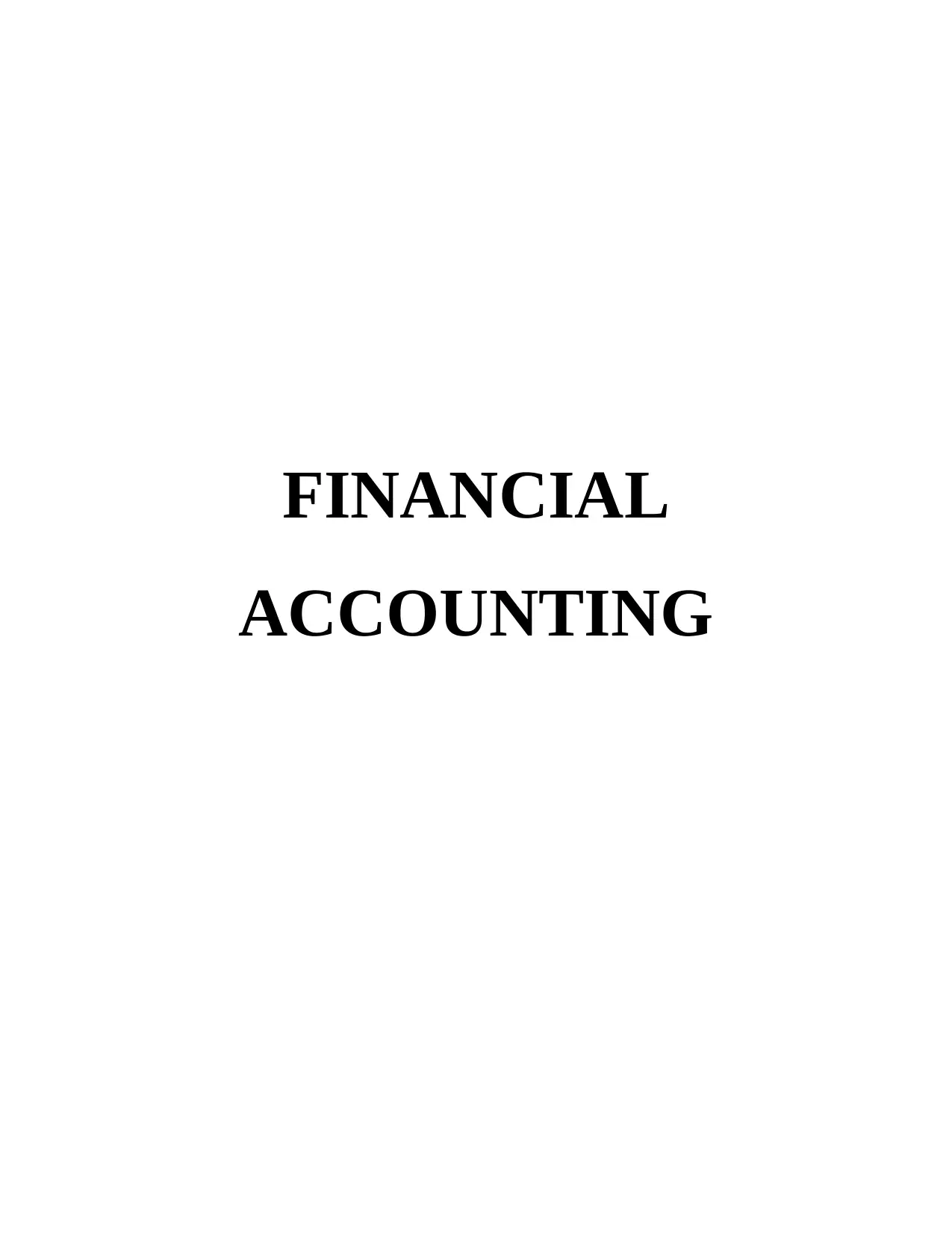
FINANCIAL
ACCOUNTING
ACCOUNTING
Secure Best Marks with AI Grader
Need help grading? Try our AI Grader for instant feedback on your assignments.
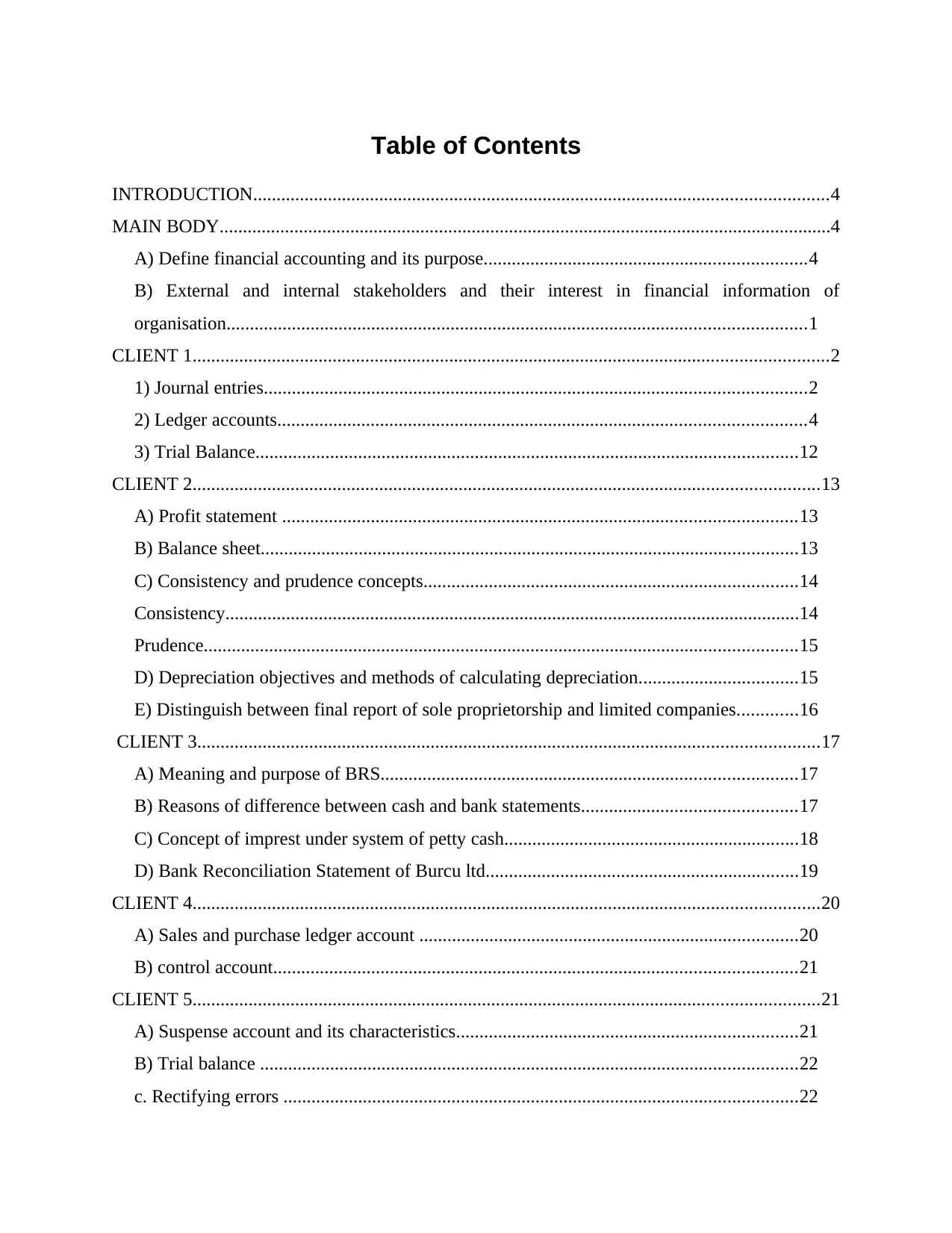
Table of Contents
INTRODUCTION...........................................................................................................................4
MAIN BODY...................................................................................................................................4
A) Define financial accounting and its purpose.....................................................................4
B) External and internal stakeholders and their interest in financial information of
organisation............................................................................................................................1
CLIENT 1........................................................................................................................................2
1) Journal entries....................................................................................................................2
2) Ledger accounts.................................................................................................................4
3) Trial Balance....................................................................................................................12
CLIENT 2......................................................................................................................................13
A) Profit statement ..............................................................................................................13
B) Balance sheet...................................................................................................................13
C) Consistency and prudence concepts................................................................................14
Consistency...........................................................................................................................14
Prudence...............................................................................................................................15
D) Depreciation objectives and methods of calculating depreciation..................................15
E) Distinguish between final report of sole proprietorship and limited companies.............16
CLIENT 3.....................................................................................................................................17
A) Meaning and purpose of BRS.........................................................................................17
B) Reasons of difference between cash and bank statements..............................................17
C) Concept of imprest under system of petty cash...............................................................18
D) Bank Reconciliation Statement of Burcu ltd...................................................................19
CLIENT 4......................................................................................................................................20
A) Sales and purchase ledger account .................................................................................20
B) control account................................................................................................................21
CLIENT 5......................................................................................................................................21
A) Suspense account and its characteristics.........................................................................21
B) Trial balance ...................................................................................................................22
c. Rectifying errors ..............................................................................................................22
INTRODUCTION...........................................................................................................................4
MAIN BODY...................................................................................................................................4
A) Define financial accounting and its purpose.....................................................................4
B) External and internal stakeholders and their interest in financial information of
organisation............................................................................................................................1
CLIENT 1........................................................................................................................................2
1) Journal entries....................................................................................................................2
2) Ledger accounts.................................................................................................................4
3) Trial Balance....................................................................................................................12
CLIENT 2......................................................................................................................................13
A) Profit statement ..............................................................................................................13
B) Balance sheet...................................................................................................................13
C) Consistency and prudence concepts................................................................................14
Consistency...........................................................................................................................14
Prudence...............................................................................................................................15
D) Depreciation objectives and methods of calculating depreciation..................................15
E) Distinguish between final report of sole proprietorship and limited companies.............16
CLIENT 3.....................................................................................................................................17
A) Meaning and purpose of BRS.........................................................................................17
B) Reasons of difference between cash and bank statements..............................................17
C) Concept of imprest under system of petty cash...............................................................18
D) Bank Reconciliation Statement of Burcu ltd...................................................................19
CLIENT 4......................................................................................................................................20
A) Sales and purchase ledger account .................................................................................20
B) control account................................................................................................................21
CLIENT 5......................................................................................................................................21
A) Suspense account and its characteristics.........................................................................21
B) Trial balance ...................................................................................................................22
c. Rectifying errors ..............................................................................................................22

CONCLUSION..............................................................................................................................24
REFERENCES..............................................................................................................................25
REFERENCES..............................................................................................................................25
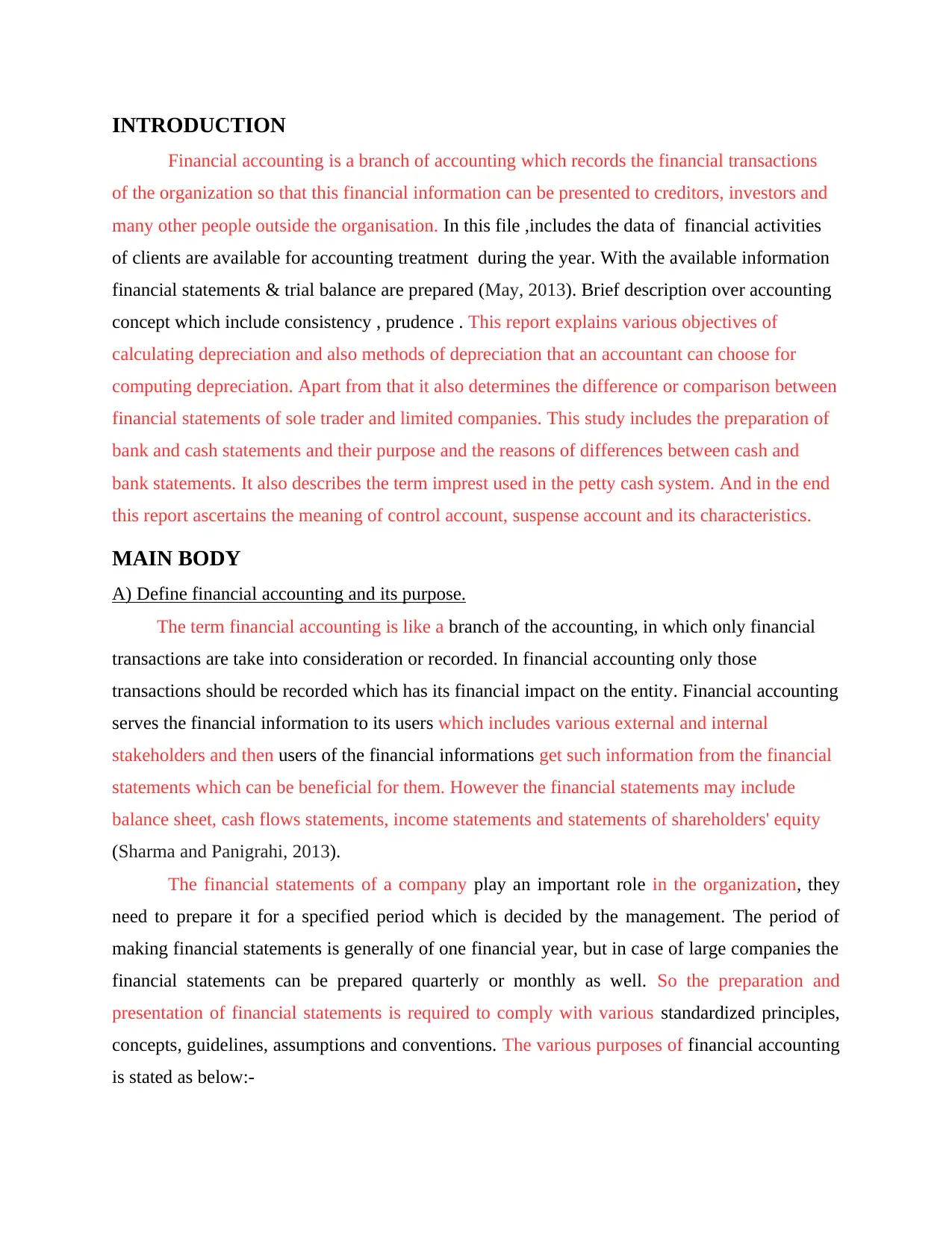
INTRODUCTION
Financial accounting is a branch of accounting which records the financial transactions
of the organization so that this financial information can be presented to creditors, investors and
many other people outside the organisation. In this file ,includes the data of financial activities
of clients are available for accounting treatment during the year. With the available information
financial statements & trial balance are prepared (May, 2013). Brief description over accounting
concept which include consistency , prudence . This report explains various objectives of
calculating depreciation and also methods of depreciation that an accountant can choose for
computing depreciation. Apart from that it also determines the difference or comparison between
financial statements of sole trader and limited companies. This study includes the preparation of
bank and cash statements and their purpose and the reasons of differences between cash and
bank statements. It also describes the term imprest used in the petty cash system. And in the end
this report ascertains the meaning of control account, suspense account and its characteristics.
MAIN BODY
A) Define financial accounting and its purpose.
The term financial accounting is like a branch of the accounting, in which only financial
transactions are take into consideration or recorded. In financial accounting only those
transactions should be recorded which has its financial impact on the entity. Financial accounting
serves the financial information to its users which includes various external and internal
stakeholders and then users of the financial informations get such information from the financial
statements which can be beneficial for them. However the financial statements may include
balance sheet, cash flows statements, income statements and statements of shareholders' equity
(Sharma and Panigrahi, 2013).
The financial statements of a company play an important role in the organization, they
need to prepare it for a specified period which is decided by the management. The period of
making financial statements is generally of one financial year, but in case of large companies the
financial statements can be prepared quarterly or monthly as well. So the preparation and
presentation of financial statements is required to comply with various standardized principles,
concepts, guidelines, assumptions and conventions. The various purposes of financial accounting
is stated as below:-
Financial accounting is a branch of accounting which records the financial transactions
of the organization so that this financial information can be presented to creditors, investors and
many other people outside the organisation. In this file ,includes the data of financial activities
of clients are available for accounting treatment during the year. With the available information
financial statements & trial balance are prepared (May, 2013). Brief description over accounting
concept which include consistency , prudence . This report explains various objectives of
calculating depreciation and also methods of depreciation that an accountant can choose for
computing depreciation. Apart from that it also determines the difference or comparison between
financial statements of sole trader and limited companies. This study includes the preparation of
bank and cash statements and their purpose and the reasons of differences between cash and
bank statements. It also describes the term imprest used in the petty cash system. And in the end
this report ascertains the meaning of control account, suspense account and its characteristics.
MAIN BODY
A) Define financial accounting and its purpose.
The term financial accounting is like a branch of the accounting, in which only financial
transactions are take into consideration or recorded. In financial accounting only those
transactions should be recorded which has its financial impact on the entity. Financial accounting
serves the financial information to its users which includes various external and internal
stakeholders and then users of the financial informations get such information from the financial
statements which can be beneficial for them. However the financial statements may include
balance sheet, cash flows statements, income statements and statements of shareholders' equity
(Sharma and Panigrahi, 2013).
The financial statements of a company play an important role in the organization, they
need to prepare it for a specified period which is decided by the management. The period of
making financial statements is generally of one financial year, but in case of large companies the
financial statements can be prepared quarterly or monthly as well. So the preparation and
presentation of financial statements is required to comply with various standardized principles,
concepts, guidelines, assumptions and conventions. The various purposes of financial accounting
is stated as below:-
Secure Best Marks with AI Grader
Need help grading? Try our AI Grader for instant feedback on your assignments.
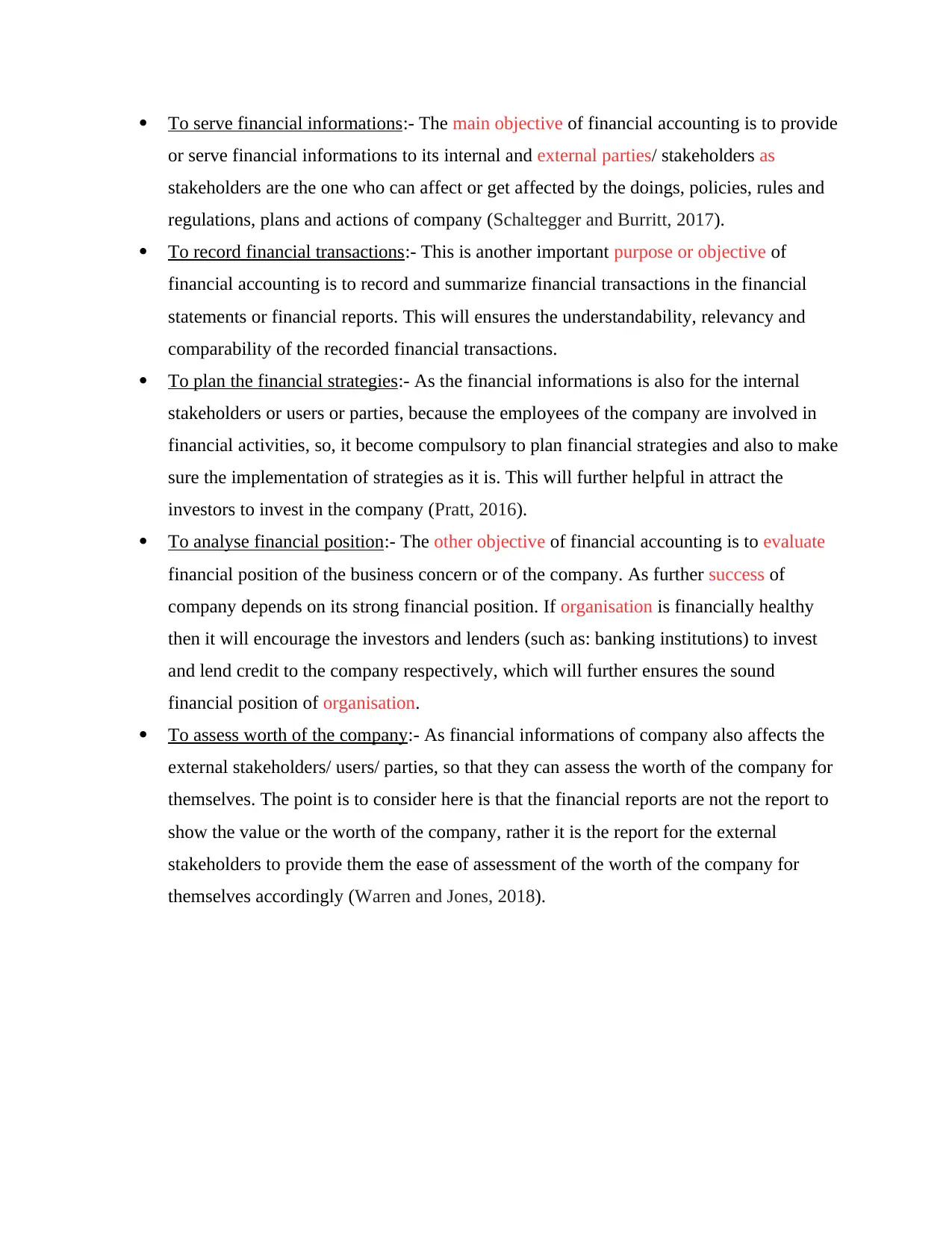
To serve financial informations:- The main objective of financial accounting is to provide
or serve financial informations to its internal and external parties/ stakeholders as
stakeholders are the one who can affect or get affected by the doings, policies, rules and
regulations, plans and actions of company (Schaltegger and Burritt, 2017).
To record financial transactions:- This is another important purpose or objective of
financial accounting is to record and summarize financial transactions in the financial
statements or financial reports. This will ensures the understandability, relevancy and
comparability of the recorded financial transactions.
To plan the financial strategies:- As the financial informations is also for the internal
stakeholders or users or parties, because the employees of the company are involved in
financial activities, so, it become compulsory to plan financial strategies and also to make
sure the implementation of strategies as it is. This will further helpful in attract the
investors to invest in the company (Pratt, 2016).
To analyse financial position:- The other objective of financial accounting is to evaluate
financial position of the business concern or of the company. As further success of
company depends on its strong financial position. If organisation is financially healthy
then it will encourage the investors and lenders (such as: banking institutions) to invest
and lend credit to the company respectively, which will further ensures the sound
financial position of organisation.
To assess worth of the company:- As financial informations of company also affects the
external stakeholders/ users/ parties, so that they can assess the worth of the company for
themselves. The point is to consider here is that the financial reports are not the report to
show the value or the worth of the company, rather it is the report for the external
stakeholders to provide them the ease of assessment of the worth of the company for
themselves accordingly (Warren and Jones, 2018).
or serve financial informations to its internal and external parties/ stakeholders as
stakeholders are the one who can affect or get affected by the doings, policies, rules and
regulations, plans and actions of company (Schaltegger and Burritt, 2017).
To record financial transactions:- This is another important purpose or objective of
financial accounting is to record and summarize financial transactions in the financial
statements or financial reports. This will ensures the understandability, relevancy and
comparability of the recorded financial transactions.
To plan the financial strategies:- As the financial informations is also for the internal
stakeholders or users or parties, because the employees of the company are involved in
financial activities, so, it become compulsory to plan financial strategies and also to make
sure the implementation of strategies as it is. This will further helpful in attract the
investors to invest in the company (Pratt, 2016).
To analyse financial position:- The other objective of financial accounting is to evaluate
financial position of the business concern or of the company. As further success of
company depends on its strong financial position. If organisation is financially healthy
then it will encourage the investors and lenders (such as: banking institutions) to invest
and lend credit to the company respectively, which will further ensures the sound
financial position of organisation.
To assess worth of the company:- As financial informations of company also affects the
external stakeholders/ users/ parties, so that they can assess the worth of the company for
themselves. The point is to consider here is that the financial reports are not the report to
show the value or the worth of the company, rather it is the report for the external
stakeholders to provide them the ease of assessment of the worth of the company for
themselves accordingly (Warren and Jones, 2018).
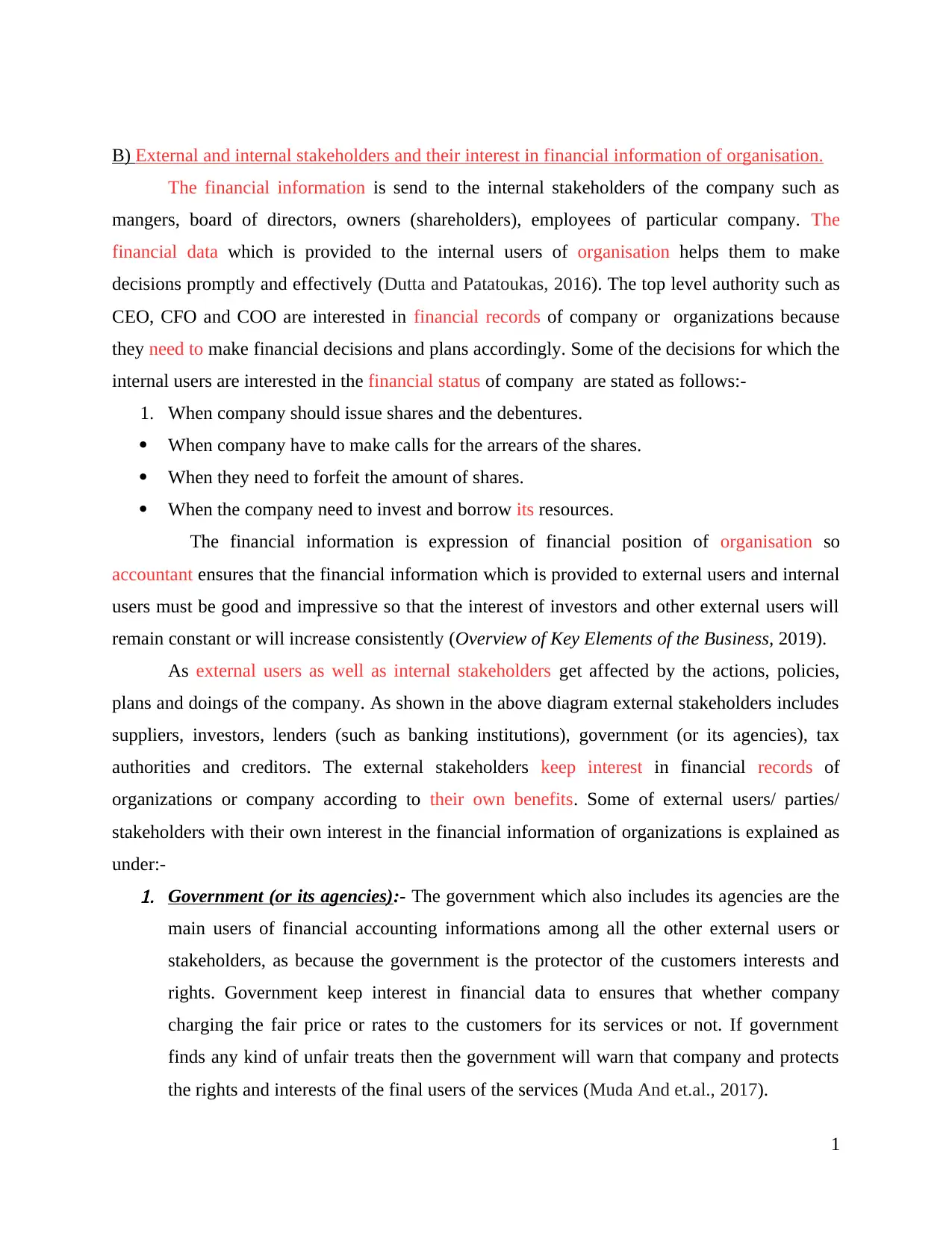
B) External and internal stakeholders and their interest in financial information of organisation.
The financial information is send to the internal stakeholders of the company such as
mangers, board of directors, owners (shareholders), employees of particular company. The
financial data which is provided to the internal users of organisation helps them to make
decisions promptly and effectively (Dutta and Patatoukas, 2016). The top level authority such as
CEO, CFO and COO are interested in financial records of company or organizations because
they need to make financial decisions and plans accordingly. Some of the decisions for which the
internal users are interested in the financial status of company are stated as follows:-
1. When company should issue shares and the debentures.
When company have to make calls for the arrears of the shares.
When they need to forfeit the amount of shares.
When the company need to invest and borrow its resources.
The financial information is expression of financial position of organisation so
accountant ensures that the financial information which is provided to external users and internal
users must be good and impressive so that the interest of investors and other external users will
remain constant or will increase consistently (Overview of Key Elements of the Business, 2019).
As external users as well as internal stakeholders get affected by the actions, policies,
plans and doings of the company. As shown in the above diagram external stakeholders includes
suppliers, investors, lenders (such as banking institutions), government (or its agencies), tax
authorities and creditors. The external stakeholders keep interest in financial records of
organizations or company according to their own benefits. Some of external users/ parties/
stakeholders with their own interest in the financial information of organizations is explained as
under:-1. Government (or its agencies):- The government which also includes its agencies are the
main users of financial accounting informations among all the other external users or
stakeholders, as because the government is the protector of the customers interests and
rights. Government keep interest in financial data to ensures that whether company
charging the fair price or rates to the customers for its services or not. If government
finds any kind of unfair treats then the government will warn that company and protects
the rights and interests of the final users of the services (Muda And et.al., 2017).
1
The financial information is send to the internal stakeholders of the company such as
mangers, board of directors, owners (shareholders), employees of particular company. The
financial data which is provided to the internal users of organisation helps them to make
decisions promptly and effectively (Dutta and Patatoukas, 2016). The top level authority such as
CEO, CFO and COO are interested in financial records of company or organizations because
they need to make financial decisions and plans accordingly. Some of the decisions for which the
internal users are interested in the financial status of company are stated as follows:-
1. When company should issue shares and the debentures.
When company have to make calls for the arrears of the shares.
When they need to forfeit the amount of shares.
When the company need to invest and borrow its resources.
The financial information is expression of financial position of organisation so
accountant ensures that the financial information which is provided to external users and internal
users must be good and impressive so that the interest of investors and other external users will
remain constant or will increase consistently (Overview of Key Elements of the Business, 2019).
As external users as well as internal stakeholders get affected by the actions, policies,
plans and doings of the company. As shown in the above diagram external stakeholders includes
suppliers, investors, lenders (such as banking institutions), government (or its agencies), tax
authorities and creditors. The external stakeholders keep interest in financial records of
organizations or company according to their own benefits. Some of external users/ parties/
stakeholders with their own interest in the financial information of organizations is explained as
under:-1. Government (or its agencies):- The government which also includes its agencies are the
main users of financial accounting informations among all the other external users or
stakeholders, as because the government is the protector of the customers interests and
rights. Government keep interest in financial data to ensures that whether company
charging the fair price or rates to the customers for its services or not. If government
finds any kind of unfair treats then the government will warn that company and protects
the rights and interests of the final users of the services (Muda And et.al., 2017).
1
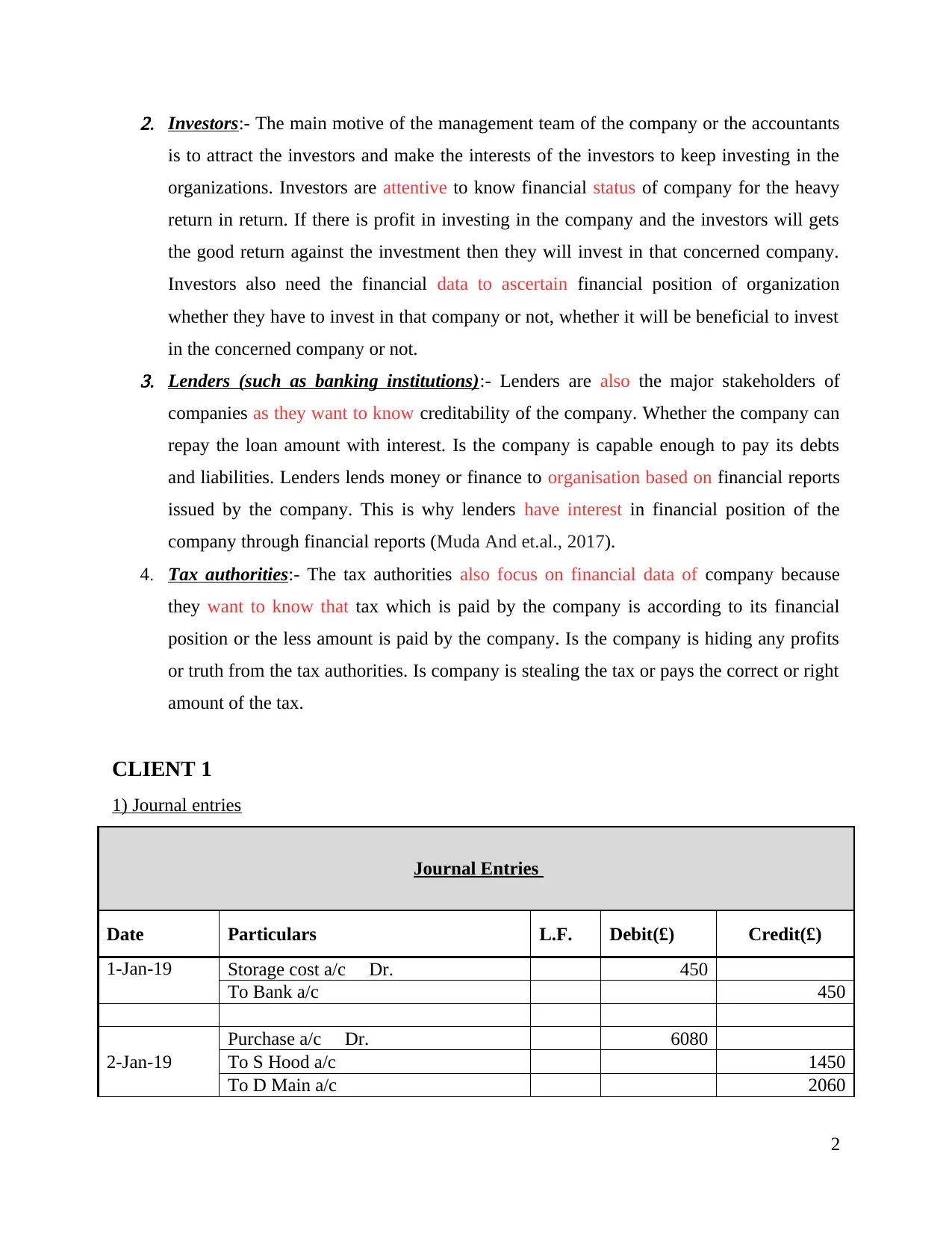
2. Investors:- The main motive of the management team of the company or the accountants
is to attract the investors and make the interests of the investors to keep investing in the
organizations. Investors are attentive to know financial status of company for the heavy
return in return. If there is profit in investing in the company and the investors will gets
the good return against the investment then they will invest in that concerned company.
Investors also need the financial data to ascertain financial position of organization
whether they have to invest in that company or not, whether it will be beneficial to invest
in the concerned company or not.3. Lenders (such as banking institutions):- Lenders are also the major stakeholders of
companies as they want to know creditability of the company. Whether the company can
repay the loan amount with interest. Is the company is capable enough to pay its debts
and liabilities. Lenders lends money or finance to organisation based on financial reports
issued by the company. This is why lenders have interest in financial position of the
company through financial reports (Muda And et.al., 2017).
4. Tax authorities:- The tax authorities also focus on financial data of company because
they want to know that tax which is paid by the company is according to its financial
position or the less amount is paid by the company. Is the company is hiding any profits
or truth from the tax authorities. Is company is stealing the tax or pays the correct or right
amount of the tax.
CLIENT 1
1) Journal entries
Journal Entries
Date Particulars L.F. Debit(£) Credit(£)
1-Jan-19 Storage cost a/c Dr. 450
To Bank a/c 450
2-Jan-19
Purchase a/c Dr. 6080
To S Hood a/c 1450
To D Main a/c 2060
2
is to attract the investors and make the interests of the investors to keep investing in the
organizations. Investors are attentive to know financial status of company for the heavy
return in return. If there is profit in investing in the company and the investors will gets
the good return against the investment then they will invest in that concerned company.
Investors also need the financial data to ascertain financial position of organization
whether they have to invest in that company or not, whether it will be beneficial to invest
in the concerned company or not.3. Lenders (such as banking institutions):- Lenders are also the major stakeholders of
companies as they want to know creditability of the company. Whether the company can
repay the loan amount with interest. Is the company is capable enough to pay its debts
and liabilities. Lenders lends money or finance to organisation based on financial reports
issued by the company. This is why lenders have interest in financial position of the
company through financial reports (Muda And et.al., 2017).
4. Tax authorities:- The tax authorities also focus on financial data of company because
they want to know that tax which is paid by the company is according to its financial
position or the less amount is paid by the company. Is the company is hiding any profits
or truth from the tax authorities. Is company is stealing the tax or pays the correct or right
amount of the tax.
CLIENT 1
1) Journal entries
Journal Entries
Date Particulars L.F. Debit(£) Credit(£)
1-Jan-19 Storage cost a/c Dr. 450
To Bank a/c 450
2-Jan-19
Purchase a/c Dr. 6080
To S Hood a/c 1450
To D Main a/c 2060
2
Paraphrase This Document
Need a fresh take? Get an instant paraphrase of this document with our AI Paraphraser
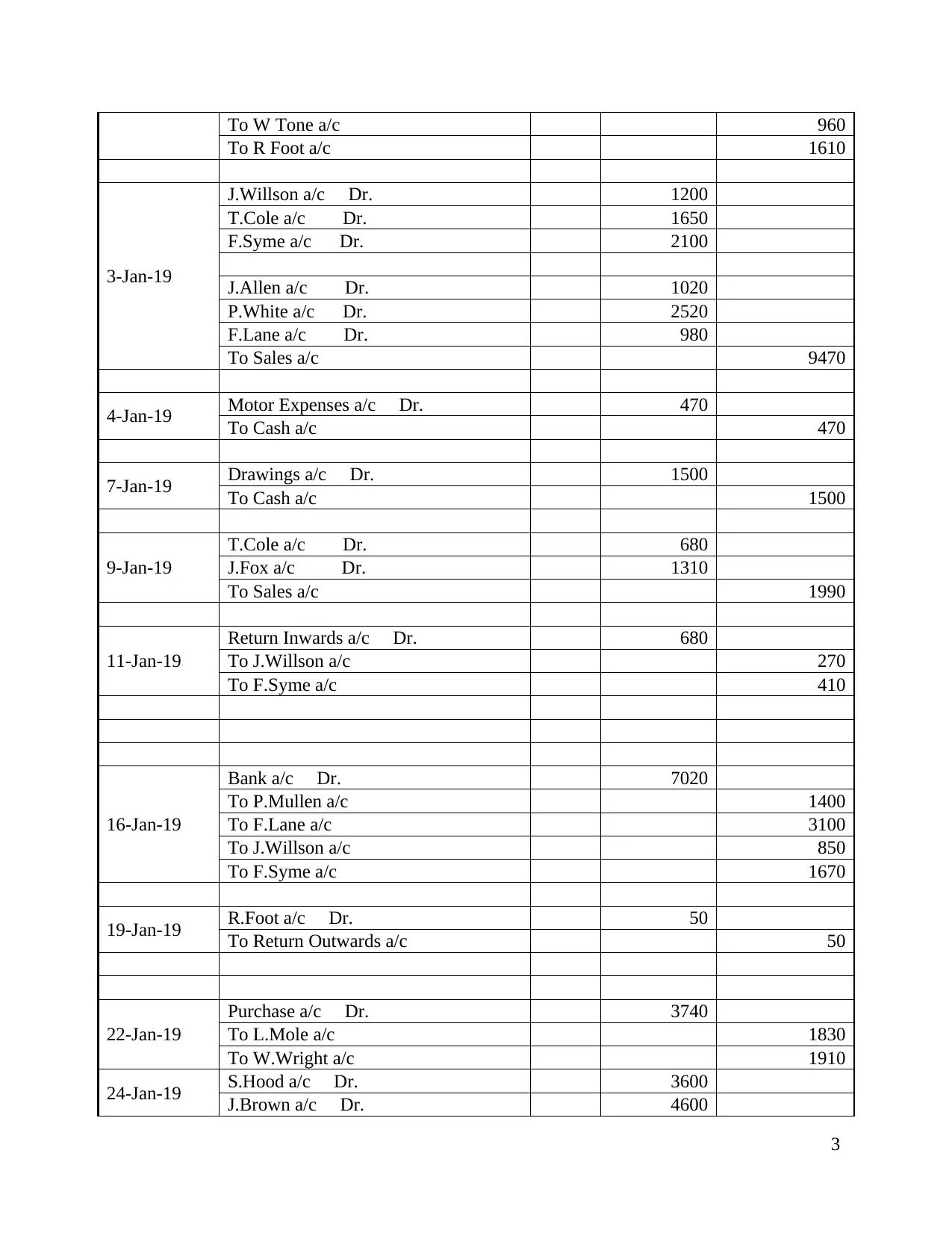
To W Tone a/c 960
To R Foot a/c 1610
3-Jan-19
J.Willson a/c Dr. 1200
T.Cole a/c Dr. 1650
F.Syme a/c Dr. 2100
J.Allen a/c Dr. 1020
P.White a/c Dr. 2520
F.Lane a/c Dr. 980
To Sales a/c 9470
4-Jan-19 Motor Expenses a/c Dr. 470
To Cash a/c 470
7-Jan-19 Drawings a/c Dr. 1500
To Cash a/c 1500
9-Jan-19
T.Cole a/c Dr. 680
J.Fox a/c Dr. 1310
To Sales a/c 1990
11-Jan-19
Return Inwards a/c Dr. 680
To J.Willson a/c 270
To F.Syme a/c 410
16-Jan-19
Bank a/c Dr. 7020
To P.Mullen a/c 1400
To F.Lane a/c 3100
To J.Willson a/c 850
To F.Syme a/c 1670
19-Jan-19 R.Foot a/c Dr. 50
To Return Outwards a/c 50
22-Jan-19
Purchase a/c Dr. 3740
To L.Mole a/c 1830
To W.Wright a/c 1910
24-Jan-19 S.Hood a/c Dr. 3600
J.Brown a/c Dr. 4600
3
To R Foot a/c 1610
3-Jan-19
J.Willson a/c Dr. 1200
T.Cole a/c Dr. 1650
F.Syme a/c Dr. 2100
J.Allen a/c Dr. 1020
P.White a/c Dr. 2520
F.Lane a/c Dr. 980
To Sales a/c 9470
4-Jan-19 Motor Expenses a/c Dr. 470
To Cash a/c 470
7-Jan-19 Drawings a/c Dr. 1500
To Cash a/c 1500
9-Jan-19
T.Cole a/c Dr. 680
J.Fox a/c Dr. 1310
To Sales a/c 1990
11-Jan-19
Return Inwards a/c Dr. 680
To J.Willson a/c 270
To F.Syme a/c 410
16-Jan-19
Bank a/c Dr. 7020
To P.Mullen a/c 1400
To F.Lane a/c 3100
To J.Willson a/c 850
To F.Syme a/c 1670
19-Jan-19 R.Foot a/c Dr. 50
To Return Outwards a/c 50
22-Jan-19
Purchase a/c Dr. 3740
To L.Mole a/c 1830
To W.Wright a/c 1910
24-Jan-19 S.Hood a/c Dr. 3600
J.Brown a/c Dr. 4600
3
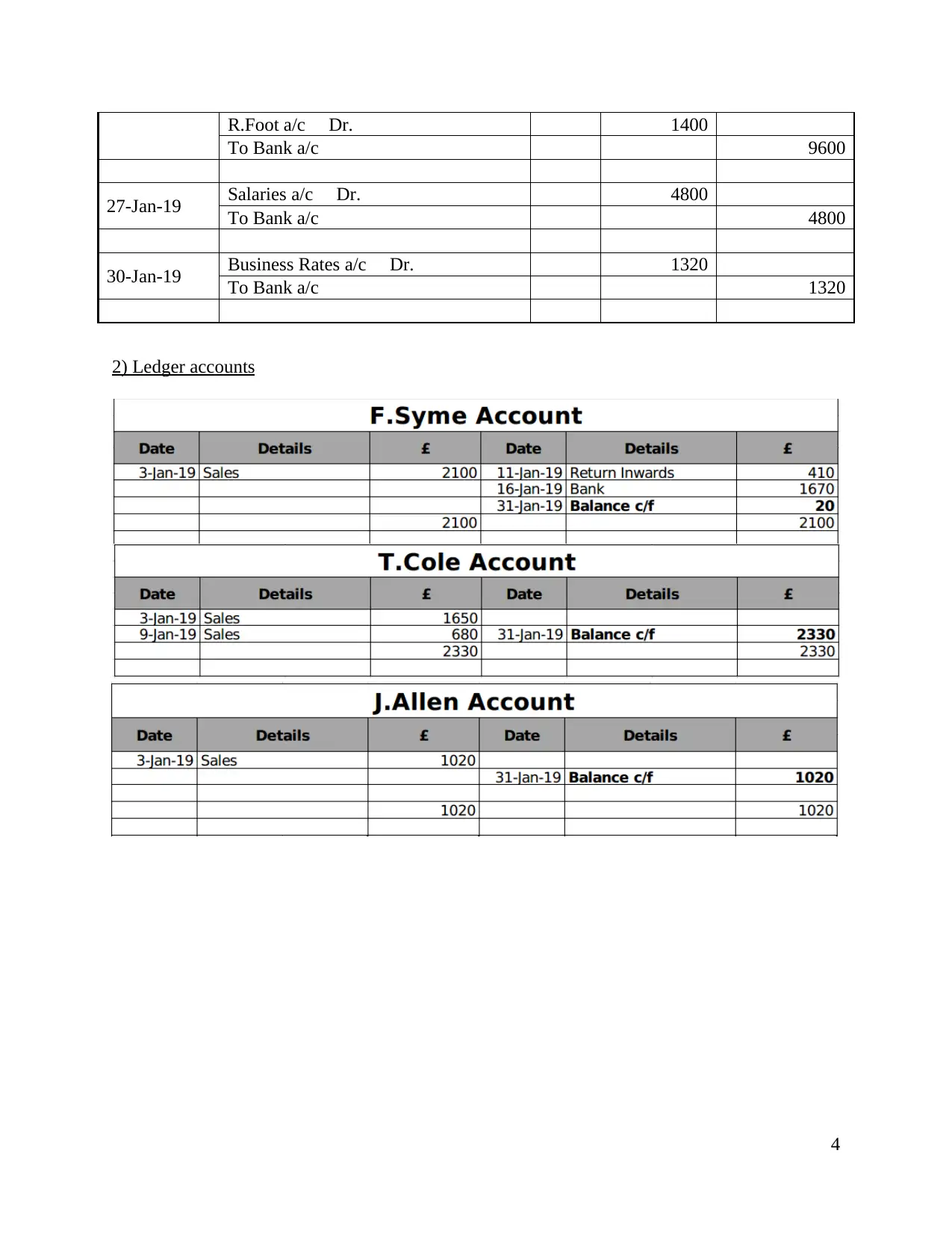
R.Foot a/c Dr. 1400
To Bank a/c 9600
27-Jan-19 Salaries a/c Dr. 4800
To Bank a/c 4800
30-Jan-19 Business Rates a/c Dr. 1320
To Bank a/c 1320
2) Ledger accounts
4
To Bank a/c 9600
27-Jan-19 Salaries a/c Dr. 4800
To Bank a/c 4800
30-Jan-19 Business Rates a/c Dr. 1320
To Bank a/c 1320
2) Ledger accounts
4
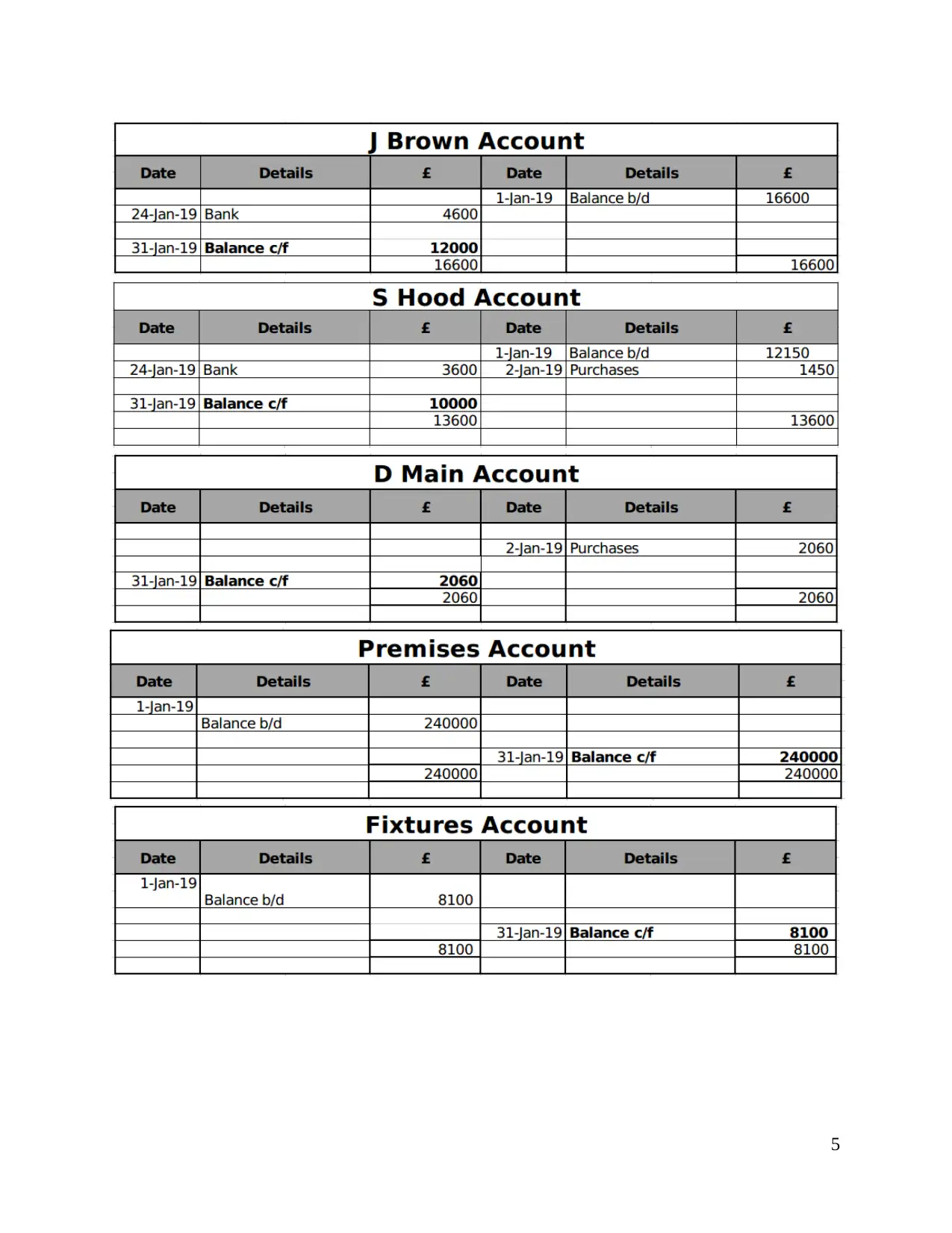
5
Secure Best Marks with AI Grader
Need help grading? Try our AI Grader for instant feedback on your assignments.
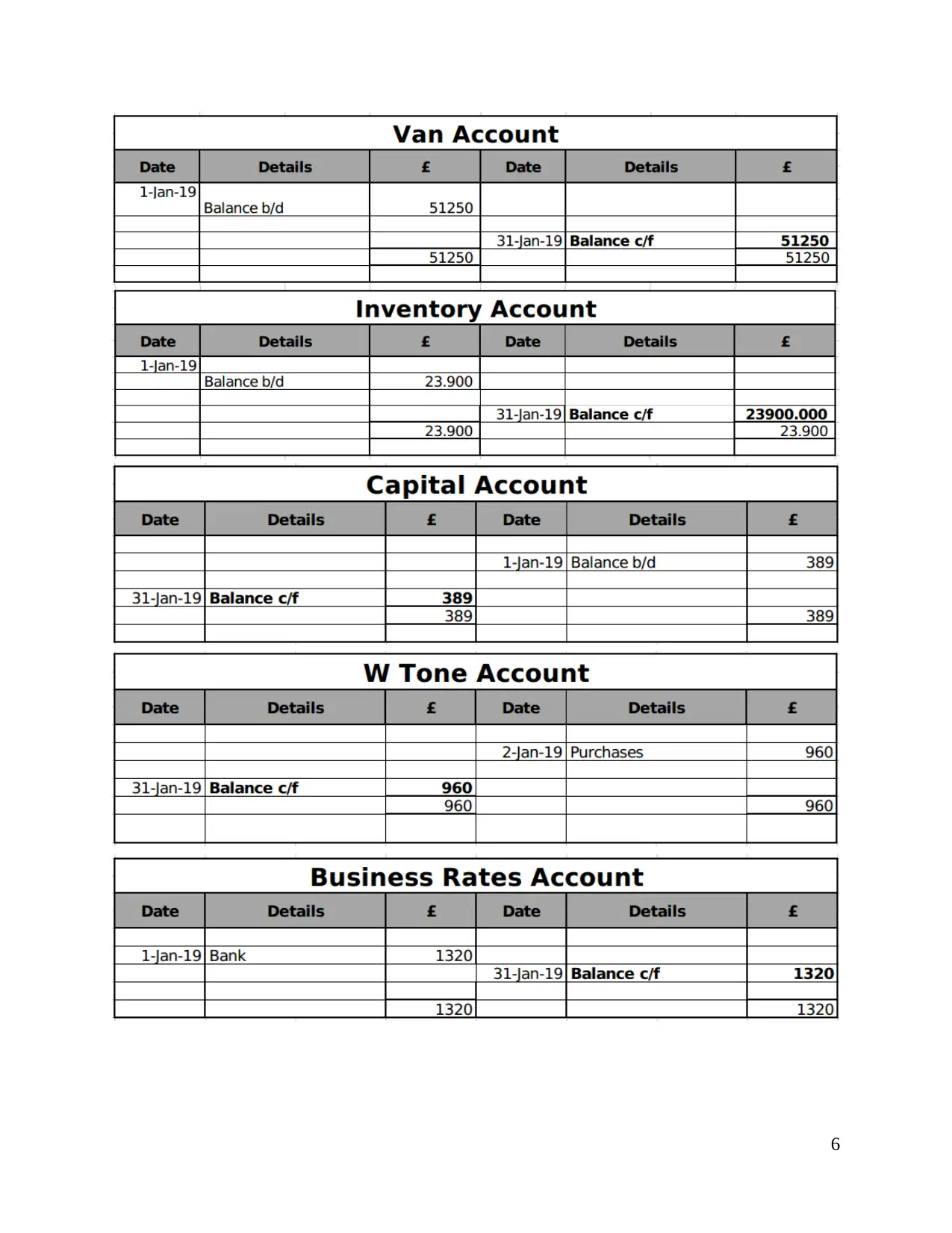
6
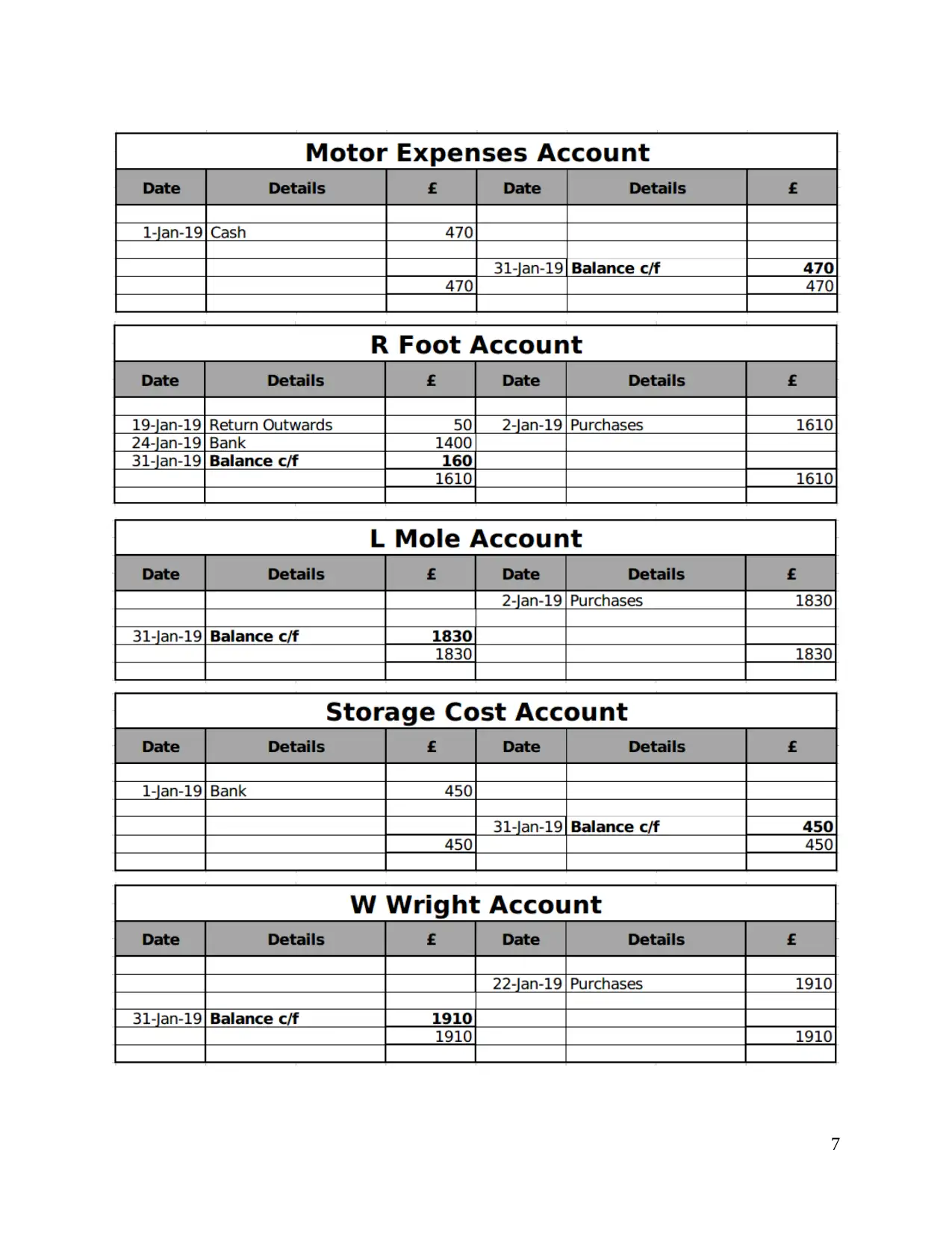
7
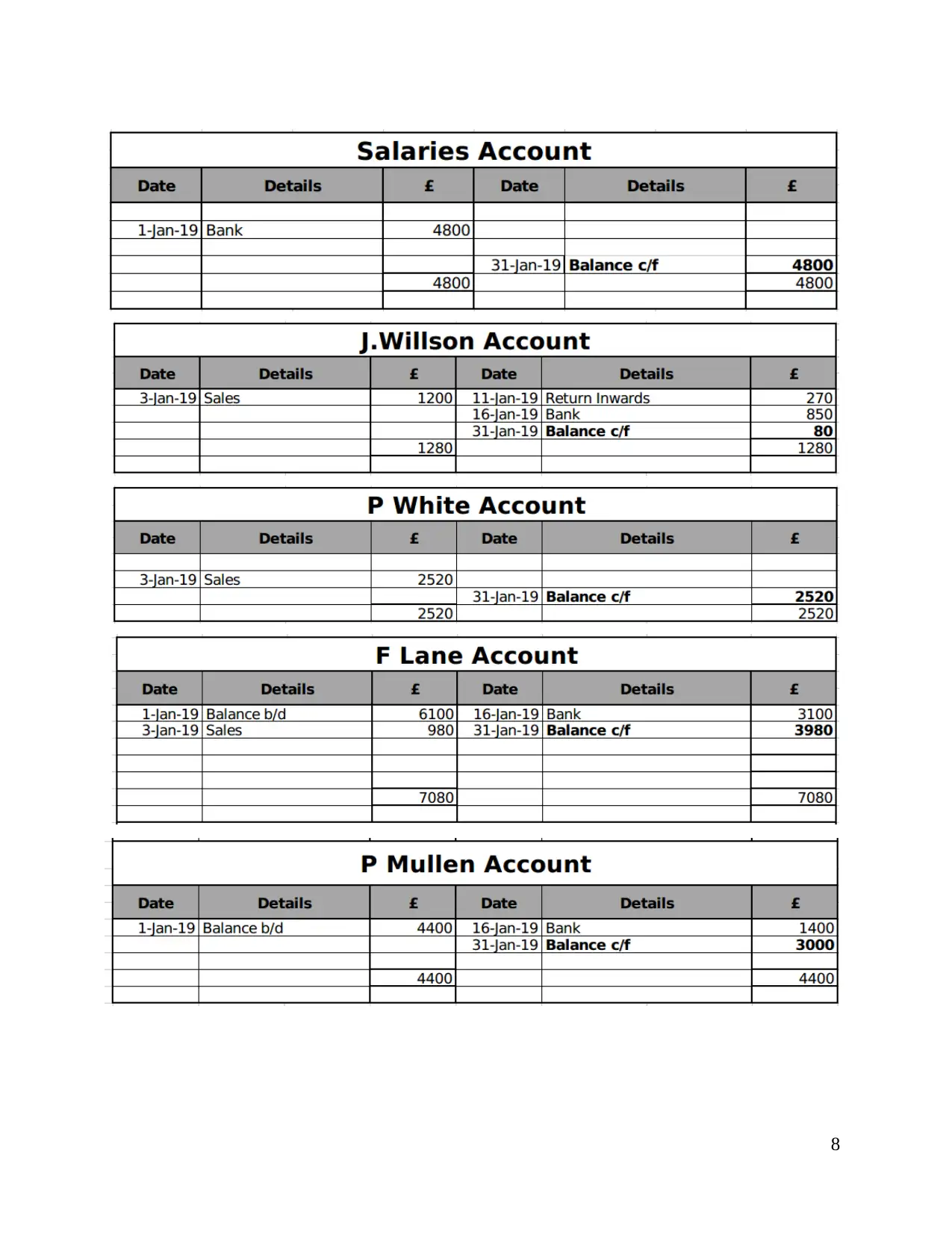
8
Paraphrase This Document
Need a fresh take? Get an instant paraphrase of this document with our AI Paraphraser
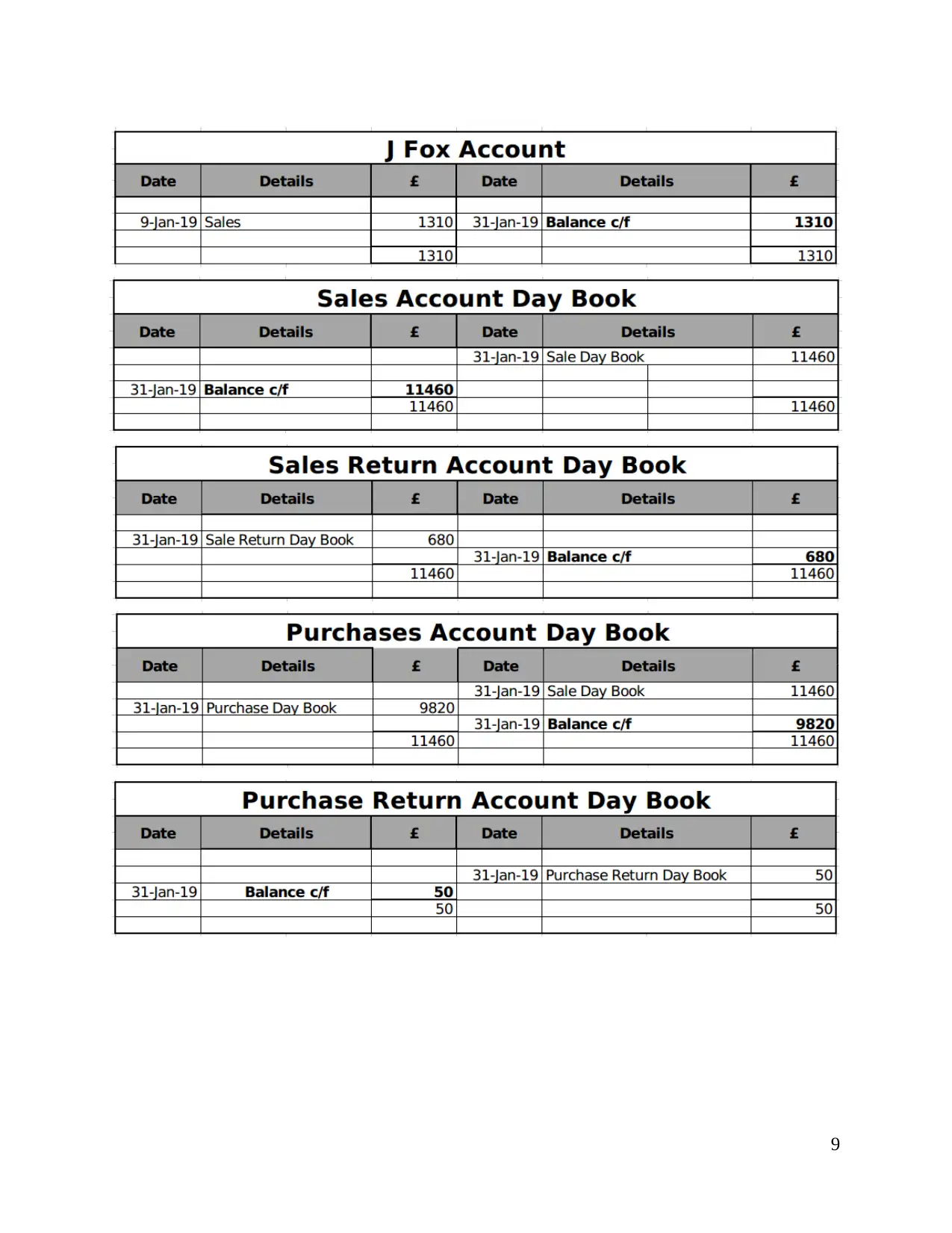
9
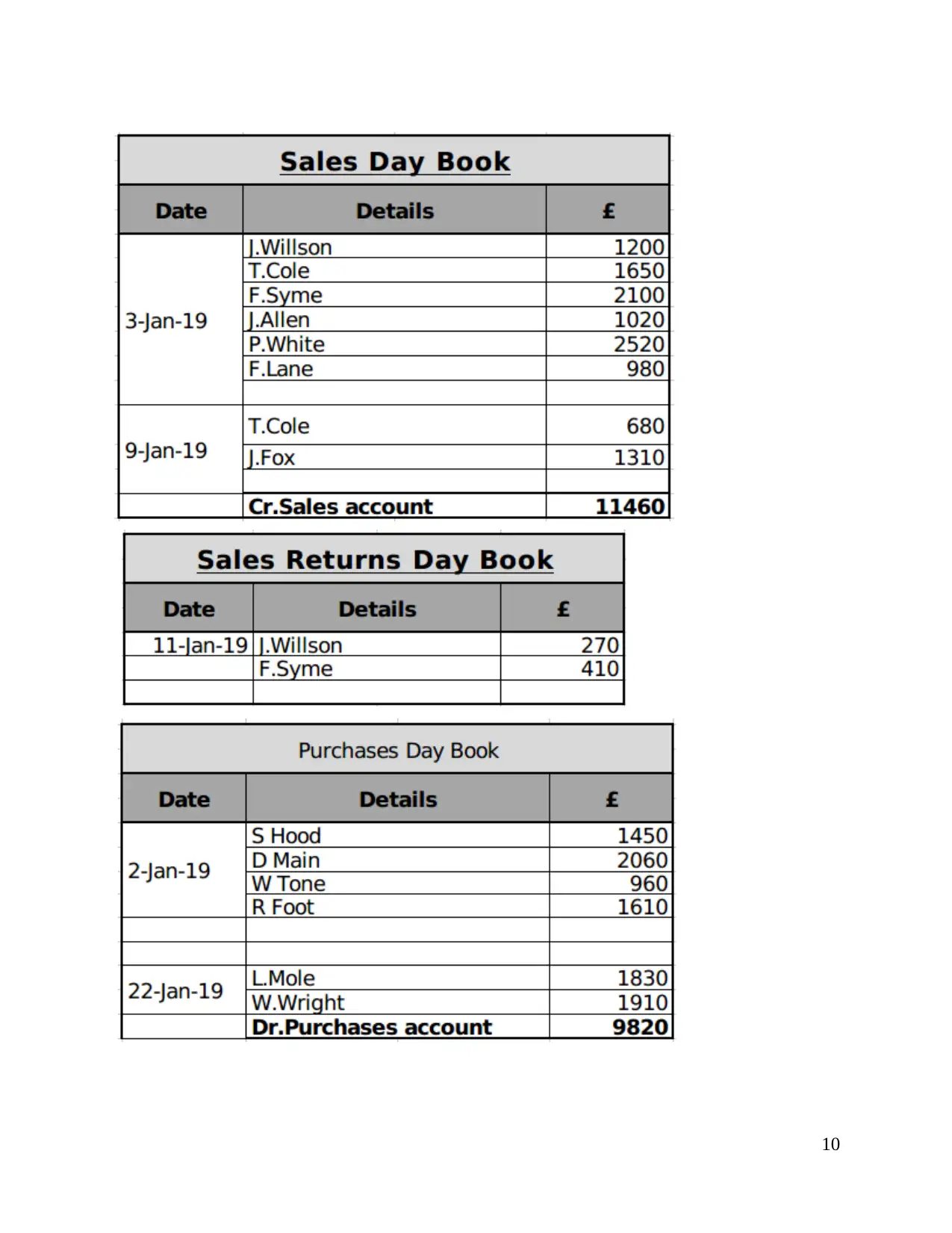
10
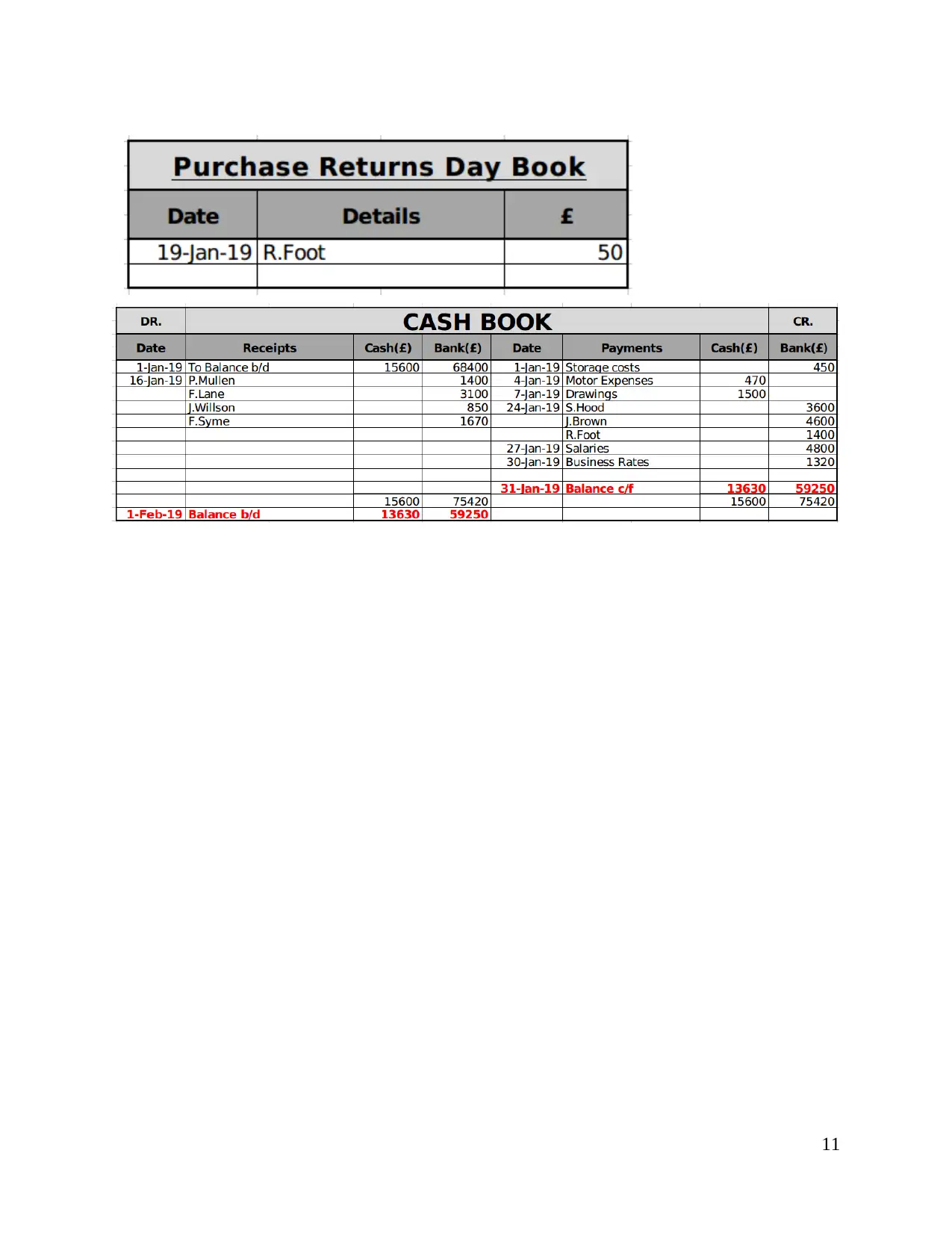
11
Secure Best Marks with AI Grader
Need help grading? Try our AI Grader for instant feedback on your assignments.
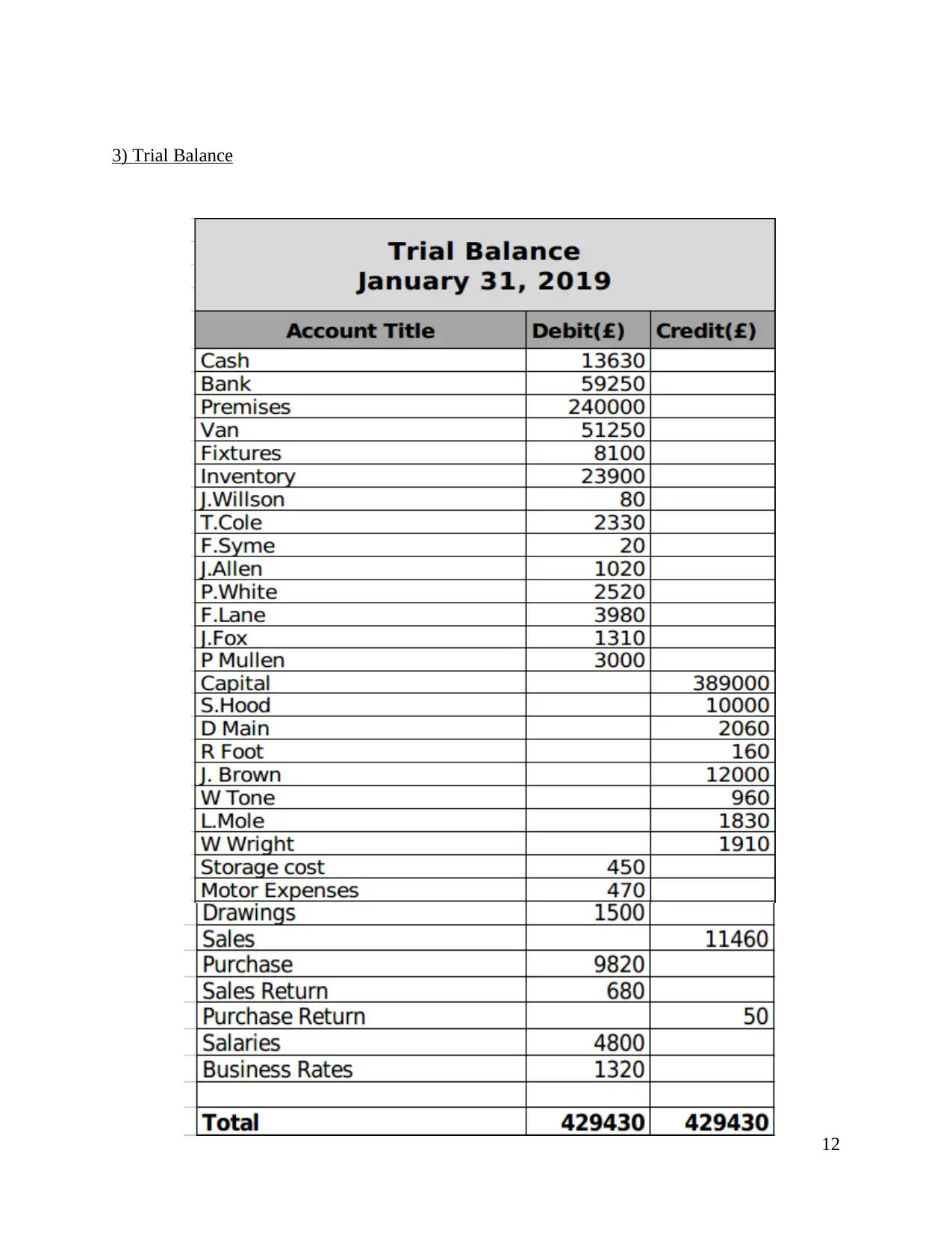
3) Trial Balance
12
12
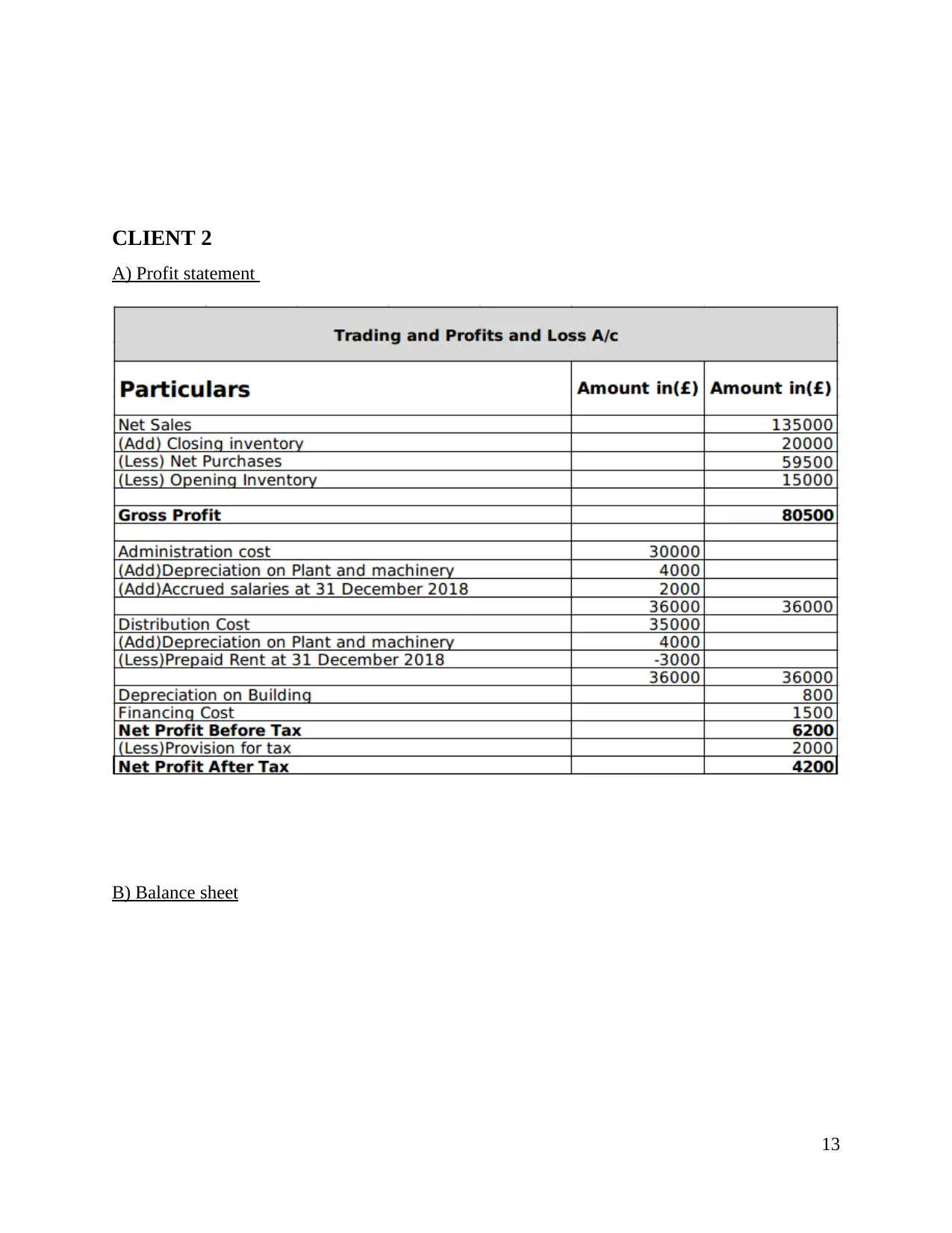
CLIENT 2
A) Profit statement
B) Balance sheet
13
A) Profit statement
B) Balance sheet
13
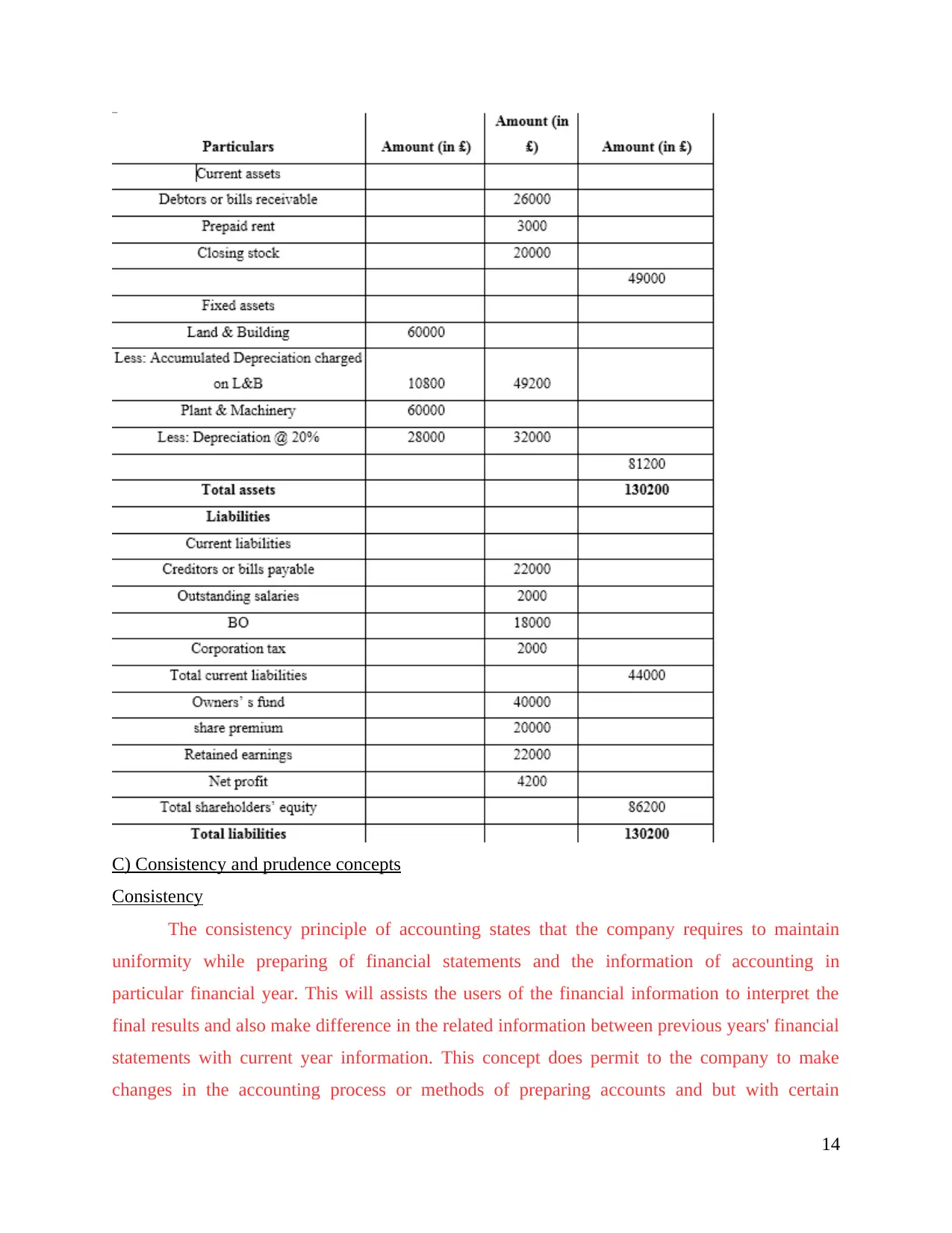
C) Consistency and prudence concepts
Consistency
The consistency principle of accounting states that the company requires to maintain
uniformity while preparing of financial statements and the information of accounting in
particular financial year. This will assists the users of the financial information to interpret the
final results and also make difference in the related information between previous years' financial
statements with current year information. This concept does permit to the company to make
changes in the accounting process or methods of preparing accounts and but with certain
14
Consistency
The consistency principle of accounting states that the company requires to maintain
uniformity while preparing of financial statements and the information of accounting in
particular financial year. This will assists the users of the financial information to interpret the
final results and also make difference in the related information between previous years' financial
statements with current year information. This concept does permit to the company to make
changes in the accounting process or methods of preparing accounts and but with certain
14
Paraphrase This Document
Need a fresh take? Get an instant paraphrase of this document with our AI Paraphraser
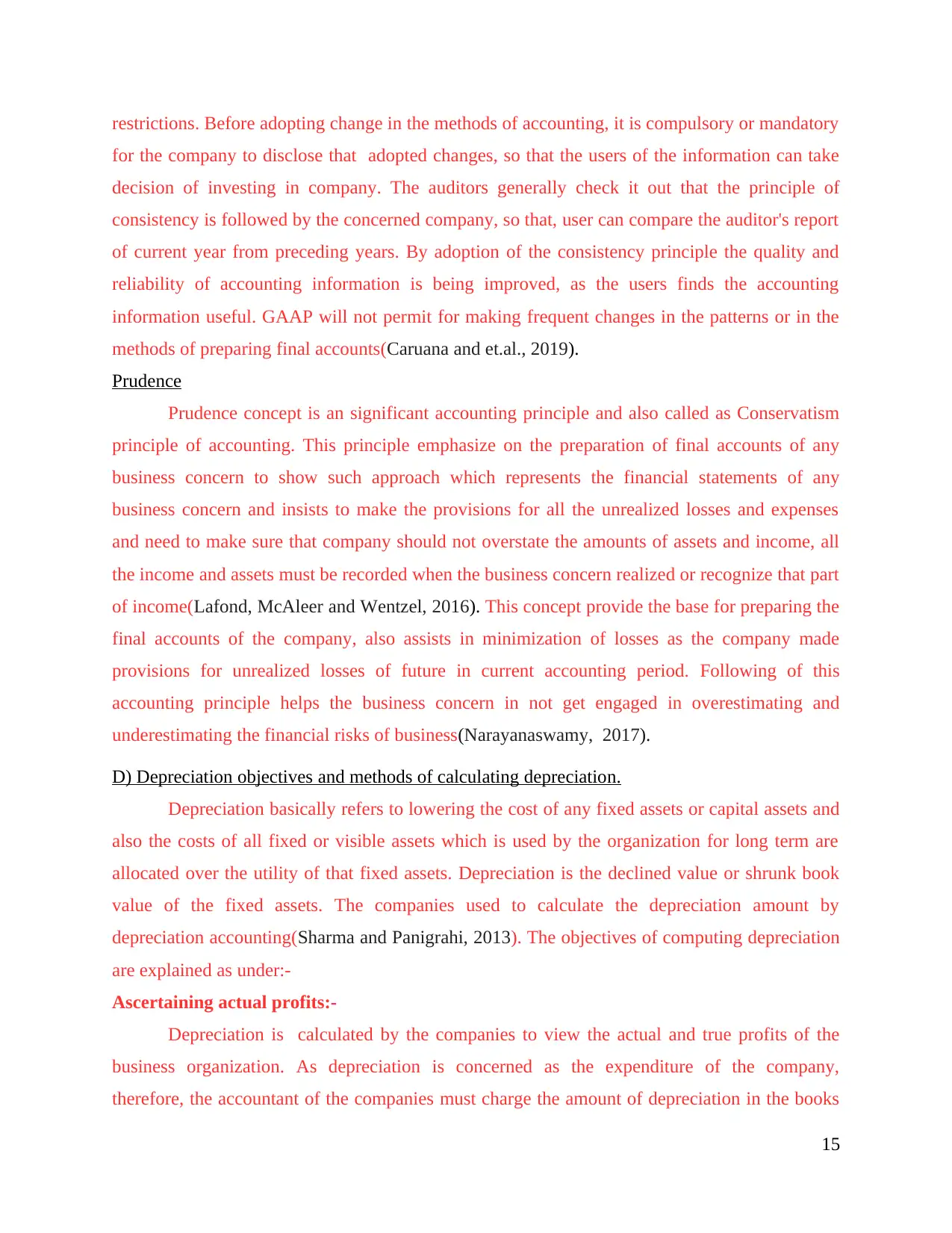
restrictions. Before adopting change in the methods of accounting, it is compulsory or mandatory
for the company to disclose that adopted changes, so that the users of the information can take
decision of investing in company. The auditors generally check it out that the principle of
consistency is followed by the concerned company, so that, user can compare the auditor's report
of current year from preceding years. By adoption of the consistency principle the quality and
reliability of accounting information is being improved, as the users finds the accounting
information useful. GAAP will not permit for making frequent changes in the patterns or in the
methods of preparing final accounts(Caruana and et.al., 2019).
Prudence
Prudence concept is an significant accounting principle and also called as Conservatism
principle of accounting. This principle emphasize on the preparation of final accounts of any
business concern to show such approach which represents the financial statements of any
business concern and insists to make the provisions for all the unrealized losses and expenses
and need to make sure that company should not overstate the amounts of assets and income, all
the income and assets must be recorded when the business concern realized or recognize that part
of income(Lafond, McAleer and Wentzel, 2016). This concept provide the base for preparing the
final accounts of the company, also assists in minimization of losses as the company made
provisions for unrealized losses of future in current accounting period. Following of this
accounting principle helps the business concern in not get engaged in overestimating and
underestimating the financial risks of business(Narayanaswamy, 2017).
D) Depreciation objectives and methods of calculating depreciation.
Depreciation basically refers to lowering the cost of any fixed assets or capital assets and
also the costs of all fixed or visible assets which is used by the organization for long term are
allocated over the utility of that fixed assets. Depreciation is the declined value or shrunk book
value of the fixed assets. The companies used to calculate the depreciation amount by
depreciation accounting(Sharma and Panigrahi, 2013). The objectives of computing depreciation
are explained as under:-
Ascertaining actual profits:-
Depreciation is calculated by the companies to view the actual and true profits of the
business organization. As depreciation is concerned as the expenditure of the company,
therefore, the accountant of the companies must charge the amount of depreciation in the books
15
for the company to disclose that adopted changes, so that the users of the information can take
decision of investing in company. The auditors generally check it out that the principle of
consistency is followed by the concerned company, so that, user can compare the auditor's report
of current year from preceding years. By adoption of the consistency principle the quality and
reliability of accounting information is being improved, as the users finds the accounting
information useful. GAAP will not permit for making frequent changes in the patterns or in the
methods of preparing final accounts(Caruana and et.al., 2019).
Prudence
Prudence concept is an significant accounting principle and also called as Conservatism
principle of accounting. This principle emphasize on the preparation of final accounts of any
business concern to show such approach which represents the financial statements of any
business concern and insists to make the provisions for all the unrealized losses and expenses
and need to make sure that company should not overstate the amounts of assets and income, all
the income and assets must be recorded when the business concern realized or recognize that part
of income(Lafond, McAleer and Wentzel, 2016). This concept provide the base for preparing the
final accounts of the company, also assists in minimization of losses as the company made
provisions for unrealized losses of future in current accounting period. Following of this
accounting principle helps the business concern in not get engaged in overestimating and
underestimating the financial risks of business(Narayanaswamy, 2017).
D) Depreciation objectives and methods of calculating depreciation.
Depreciation basically refers to lowering the cost of any fixed assets or capital assets and
also the costs of all fixed or visible assets which is used by the organization for long term are
allocated over the utility of that fixed assets. Depreciation is the declined value or shrunk book
value of the fixed assets. The companies used to calculate the depreciation amount by
depreciation accounting(Sharma and Panigrahi, 2013). The objectives of computing depreciation
are explained as under:-
Ascertaining actual profits:-
Depreciation is calculated by the companies to view the actual and true profits of the
business organization. As depreciation is concerned as the expenditure of the company,
therefore, the accountant of the companies must charge the amount of depreciation in the books
15
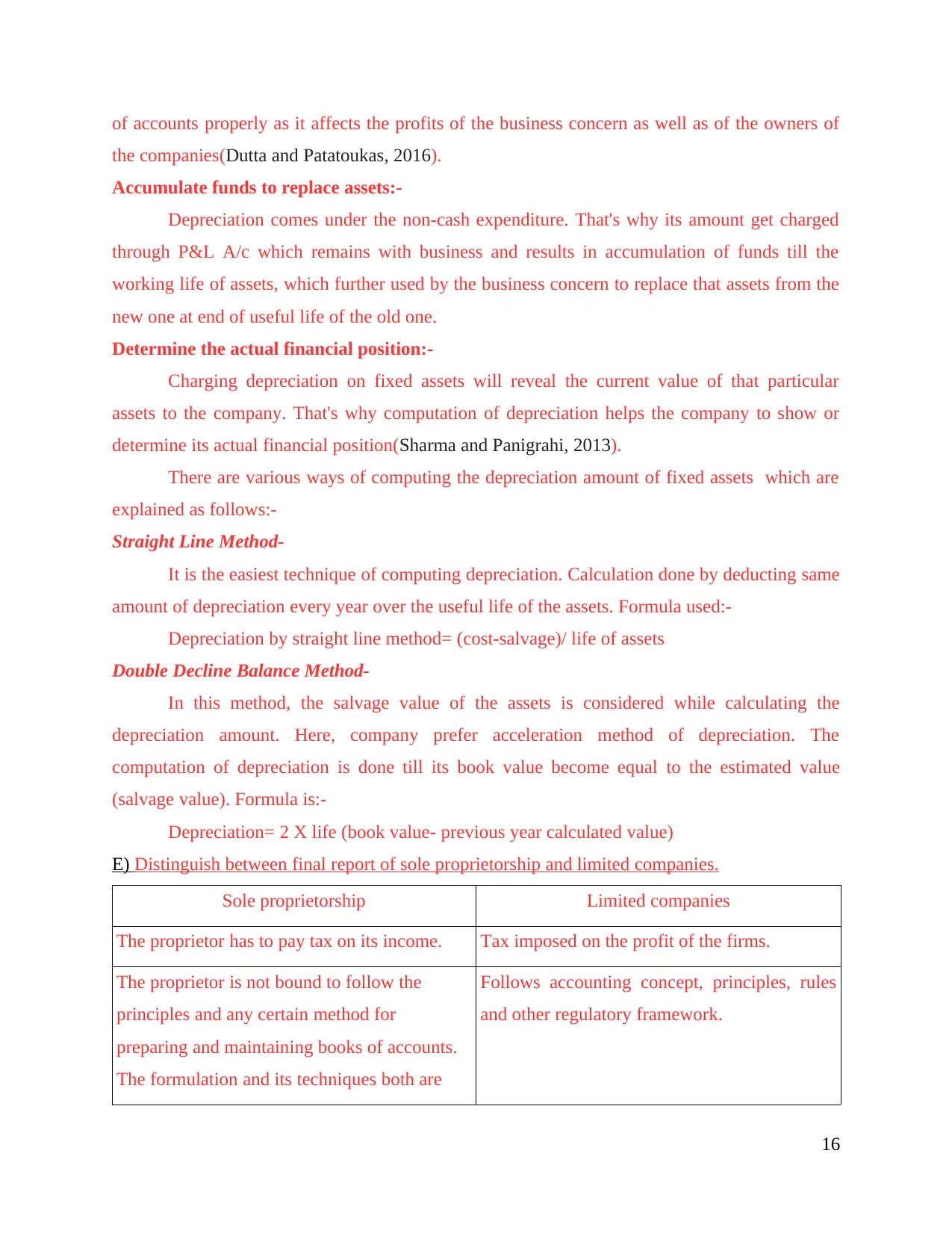
of accounts properly as it affects the profits of the business concern as well as of the owners of
the companies(Dutta and Patatoukas, 2016).
Accumulate funds to replace assets:-
Depreciation comes under the non-cash expenditure. That's why its amount get charged
through P&L A/c which remains with business and results in accumulation of funds till the
working life of assets, which further used by the business concern to replace that assets from the
new one at end of useful life of the old one.
Determine the actual financial position:-
Charging depreciation on fixed assets will reveal the current value of that particular
assets to the company. That's why computation of depreciation helps the company to show or
determine its actual financial position(Sharma and Panigrahi, 2013).
There are various ways of computing the depreciation amount of fixed assets which are
explained as follows:-
Straight Line Method-
It is the easiest technique of computing depreciation. Calculation done by deducting same
amount of depreciation every year over the useful life of the assets. Formula used:-
Depreciation by straight line method= (cost-salvage)/ life of assets
Double Decline Balance Method-
In this method, the salvage value of the assets is considered while calculating the
depreciation amount. Here, company prefer acceleration method of depreciation. The
computation of depreciation is done till its book value become equal to the estimated value
(salvage value). Formula is:-
Depreciation= 2 X life (book value- previous year calculated value)
E) Distinguish between final report of sole proprietorship and limited companies.
Sole proprietorship Limited companies
The proprietor has to pay tax on its income. Tax imposed on the profit of the firms.
The proprietor is not bound to follow the
principles and any certain method for
preparing and maintaining books of accounts.
The formulation and its techniques both are
Follows accounting concept, principles, rules
and other regulatory framework.
16
the companies(Dutta and Patatoukas, 2016).
Accumulate funds to replace assets:-
Depreciation comes under the non-cash expenditure. That's why its amount get charged
through P&L A/c which remains with business and results in accumulation of funds till the
working life of assets, which further used by the business concern to replace that assets from the
new one at end of useful life of the old one.
Determine the actual financial position:-
Charging depreciation on fixed assets will reveal the current value of that particular
assets to the company. That's why computation of depreciation helps the company to show or
determine its actual financial position(Sharma and Panigrahi, 2013).
There are various ways of computing the depreciation amount of fixed assets which are
explained as follows:-
Straight Line Method-
It is the easiest technique of computing depreciation. Calculation done by deducting same
amount of depreciation every year over the useful life of the assets. Formula used:-
Depreciation by straight line method= (cost-salvage)/ life of assets
Double Decline Balance Method-
In this method, the salvage value of the assets is considered while calculating the
depreciation amount. Here, company prefer acceleration method of depreciation. The
computation of depreciation is done till its book value become equal to the estimated value
(salvage value). Formula is:-
Depreciation= 2 X life (book value- previous year calculated value)
E) Distinguish between final report of sole proprietorship and limited companies.
Sole proprietorship Limited companies
The proprietor has to pay tax on its income. Tax imposed on the profit of the firms.
The proprietor is not bound to follow the
principles and any certain method for
preparing and maintaining books of accounts.
The formulation and its techniques both are
Follows accounting concept, principles, rules
and other regulatory framework.
16
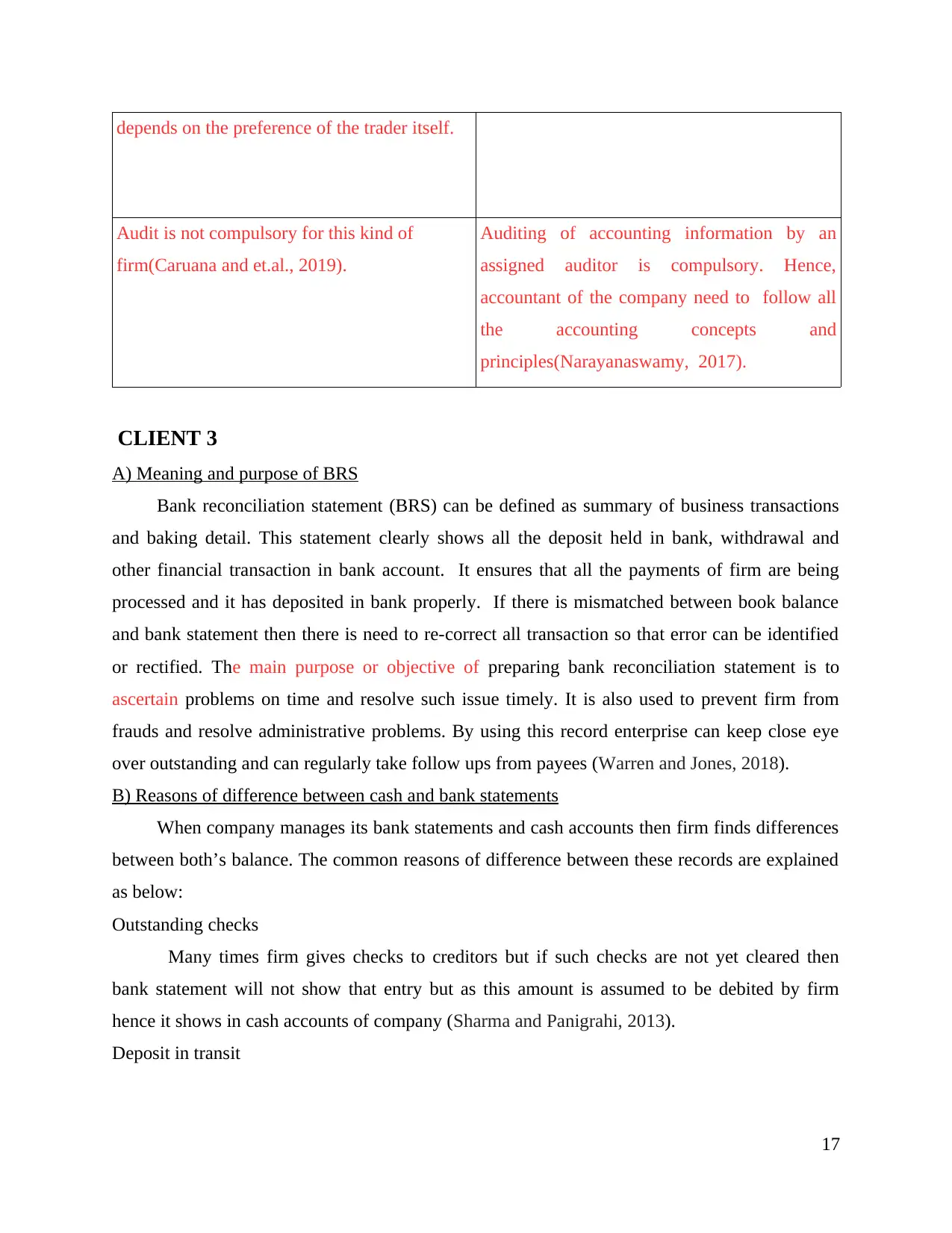
depends on the preference of the trader itself.
Audit is not compulsory for this kind of
firm(Caruana and et.al., 2019).
Auditing of accounting information by an
assigned auditor is compulsory. Hence,
accountant of the company need to follow all
the accounting concepts and
principles(Narayanaswamy, 2017).
CLIENT 3
A) Meaning and purpose of BRS
Bank reconciliation statement (BRS) can be defined as summary of business transactions
and baking detail. This statement clearly shows all the deposit held in bank, withdrawal and
other financial transaction in bank account. It ensures that all the payments of firm are being
processed and it has deposited in bank properly. If there is mismatched between book balance
and bank statement then there is need to re-correct all transaction so that error can be identified
or rectified. The main purpose or objective of preparing bank reconciliation statement is to
ascertain problems on time and resolve such issue timely. It is also used to prevent firm from
frauds and resolve administrative problems. By using this record enterprise can keep close eye
over outstanding and can regularly take follow ups from payees (Warren and Jones, 2018).
B) Reasons of difference between cash and bank statements
When company manages its bank statements and cash accounts then firm finds differences
between both’s balance. The common reasons of difference between these records are explained
as below:
Outstanding checks
Many times firm gives checks to creditors but if such checks are not yet cleared then
bank statement will not show that entry but as this amount is assumed to be debited by firm
hence it shows in cash accounts of company (Sharma and Panigrahi, 2013).
Deposit in transit
17
Audit is not compulsory for this kind of
firm(Caruana and et.al., 2019).
Auditing of accounting information by an
assigned auditor is compulsory. Hence,
accountant of the company need to follow all
the accounting concepts and
principles(Narayanaswamy, 2017).
CLIENT 3
A) Meaning and purpose of BRS
Bank reconciliation statement (BRS) can be defined as summary of business transactions
and baking detail. This statement clearly shows all the deposit held in bank, withdrawal and
other financial transaction in bank account. It ensures that all the payments of firm are being
processed and it has deposited in bank properly. If there is mismatched between book balance
and bank statement then there is need to re-correct all transaction so that error can be identified
or rectified. The main purpose or objective of preparing bank reconciliation statement is to
ascertain problems on time and resolve such issue timely. It is also used to prevent firm from
frauds and resolve administrative problems. By using this record enterprise can keep close eye
over outstanding and can regularly take follow ups from payees (Warren and Jones, 2018).
B) Reasons of difference between cash and bank statements
When company manages its bank statements and cash accounts then firm finds differences
between both’s balance. The common reasons of difference between these records are explained
as below:
Outstanding checks
Many times firm gives checks to creditors but if such checks are not yet cleared then
bank statement will not show that entry but as this amount is assumed to be debited by firm
hence it shows in cash accounts of company (Sharma and Panigrahi, 2013).
Deposit in transit
17
Secure Best Marks with AI Grader
Need help grading? Try our AI Grader for instant feedback on your assignments.
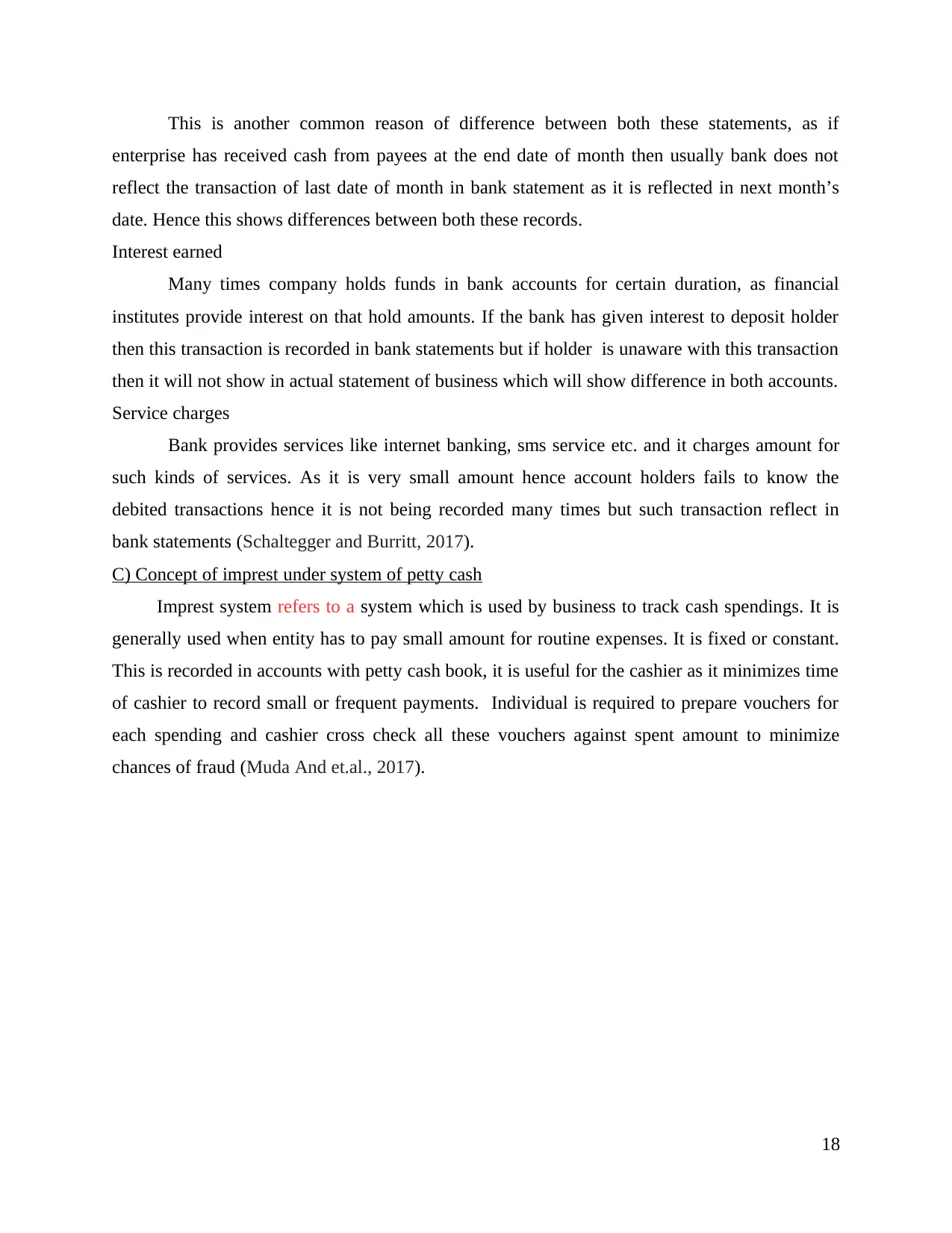
This is another common reason of difference between both these statements, as if
enterprise has received cash from payees at the end date of month then usually bank does not
reflect the transaction of last date of month in bank statement as it is reflected in next month’s
date. Hence this shows differences between both these records.
Interest earned
Many times company holds funds in bank accounts for certain duration, as financial
institutes provide interest on that hold amounts. If the bank has given interest to deposit holder
then this transaction is recorded in bank statements but if holder is unaware with this transaction
then it will not show in actual statement of business which will show difference in both accounts.
Service charges
Bank provides services like internet banking, sms service etc. and it charges amount for
such kinds of services. As it is very small amount hence account holders fails to know the
debited transactions hence it is not being recorded many times but such transaction reflect in
bank statements (Schaltegger and Burritt, 2017).
C) Concept of imprest under system of petty cash
Imprest system refers to a system which is used by business to track cash spendings. It is
generally used when entity has to pay small amount for routine expenses. It is fixed or constant.
This is recorded in accounts with petty cash book, it is useful for the cashier as it minimizes time
of cashier to record small or frequent payments. Individual is required to prepare vouchers for
each spending and cashier cross check all these vouchers against spent amount to minimize
chances of fraud (Muda And et.al., 2017).
18
enterprise has received cash from payees at the end date of month then usually bank does not
reflect the transaction of last date of month in bank statement as it is reflected in next month’s
date. Hence this shows differences between both these records.
Interest earned
Many times company holds funds in bank accounts for certain duration, as financial
institutes provide interest on that hold amounts. If the bank has given interest to deposit holder
then this transaction is recorded in bank statements but if holder is unaware with this transaction
then it will not show in actual statement of business which will show difference in both accounts.
Service charges
Bank provides services like internet banking, sms service etc. and it charges amount for
such kinds of services. As it is very small amount hence account holders fails to know the
debited transactions hence it is not being recorded many times but such transaction reflect in
bank statements (Schaltegger and Burritt, 2017).
C) Concept of imprest under system of petty cash
Imprest system refers to a system which is used by business to track cash spendings. It is
generally used when entity has to pay small amount for routine expenses. It is fixed or constant.
This is recorded in accounts with petty cash book, it is useful for the cashier as it minimizes time
of cashier to record small or frequent payments. Individual is required to prepare vouchers for
each spending and cashier cross check all these vouchers against spent amount to minimize
chances of fraud (Muda And et.al., 2017).
18
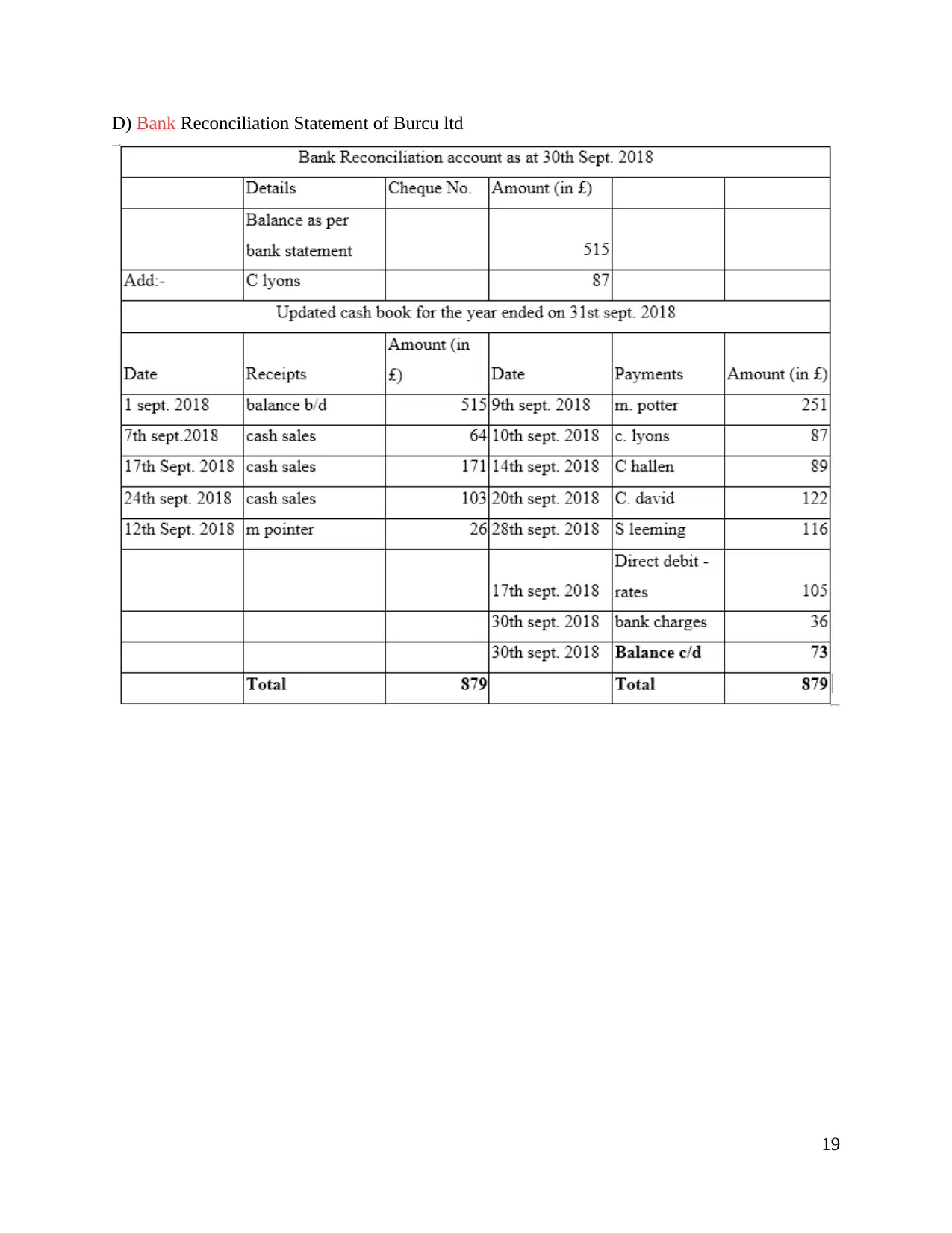
D) Bank Reconciliation Statement of Burcu ltd
19
19
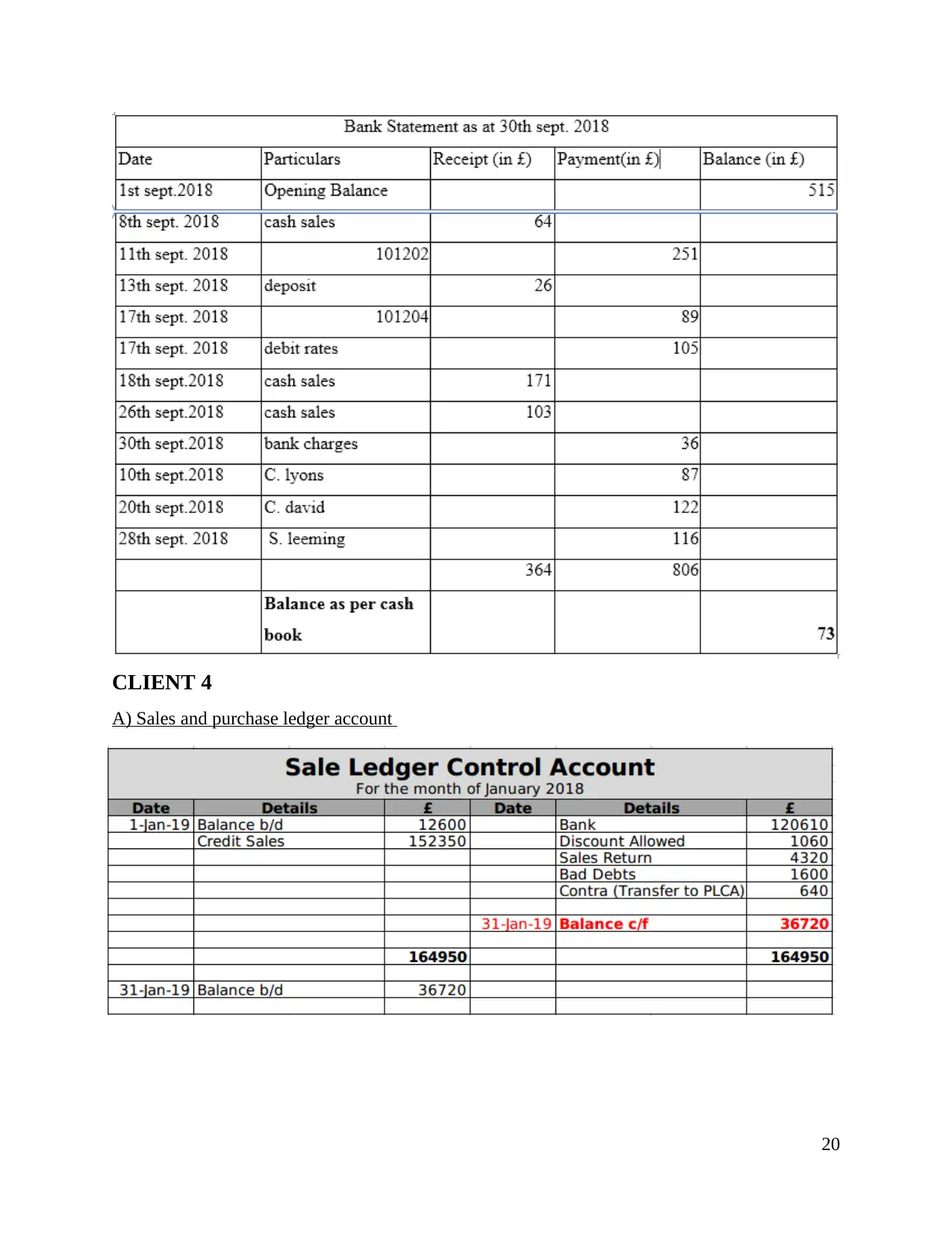
CLIENT 4
A) Sales and purchase ledger account
20
A) Sales and purchase ledger account
20
Paraphrase This Document
Need a fresh take? Get an instant paraphrase of this document with our AI Paraphraser
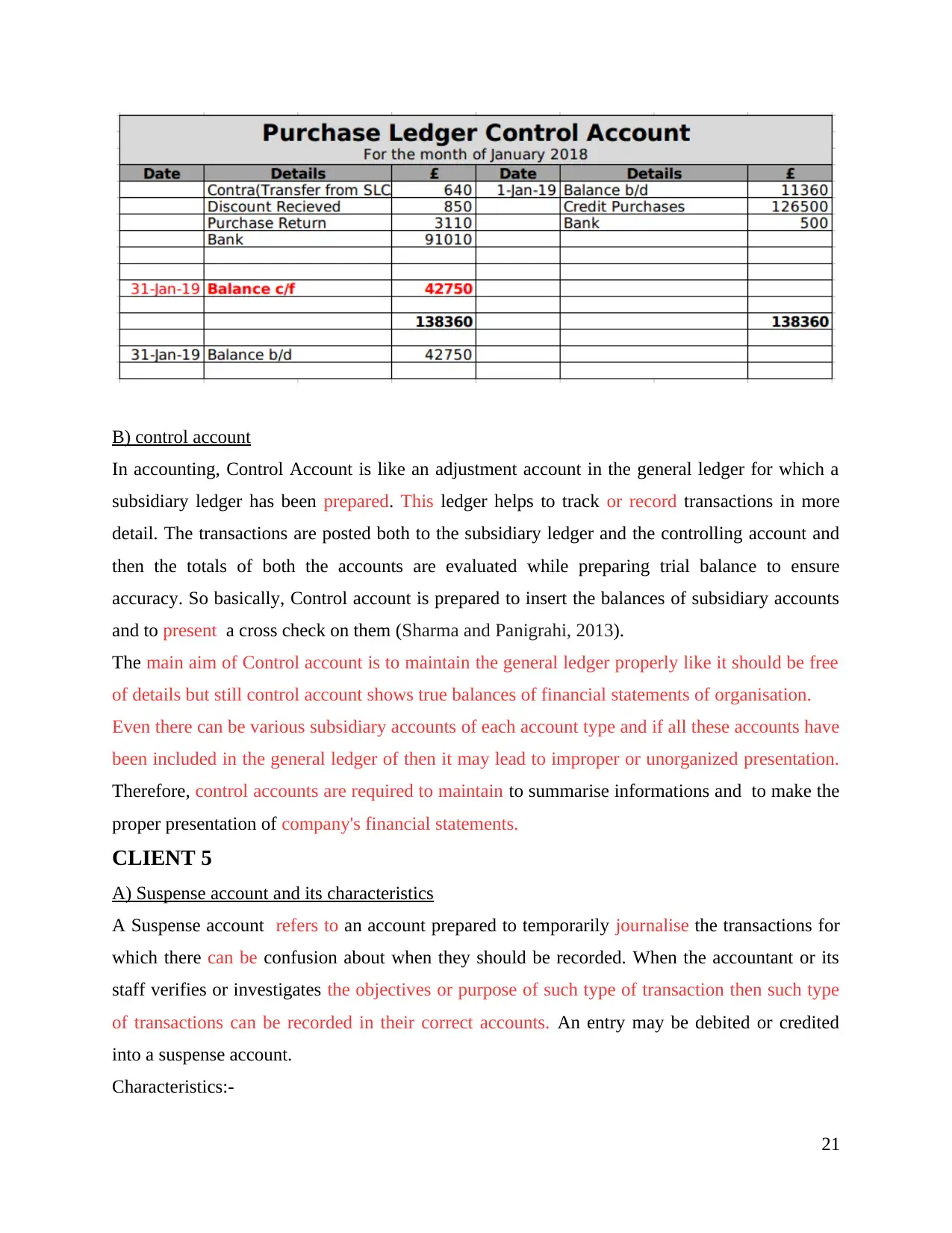
B) control account
In accounting, Control Account is like an adjustment account in the general ledger for which a
subsidiary ledger has been prepared. This ledger helps to track or record transactions in more
detail. The transactions are posted both to the subsidiary ledger and the controlling account and
then the totals of both the accounts are evaluated while preparing trial balance to ensure
accuracy. So basically, Control account is prepared to insert the balances of subsidiary accounts
and to present a cross check on them (Sharma and Panigrahi, 2013).
The main aim of Control account is to maintain the general ledger properly like it should be free
of details but still control account shows true balances of financial statements of organisation.
Even there can be various subsidiary accounts of each account type and if all these accounts have
been included in the general ledger of then it may lead to improper or unorganized presentation.
Therefore, control accounts are required to maintain to summarise informations and to make the
proper presentation of company's financial statements.
CLIENT 5
A) Suspense account and its characteristics
A Suspense account refers to an account prepared to temporarily journalise the transactions for
which there can be confusion about when they should be recorded. When the accountant or its
staff verifies or investigates the objectives or purpose of such type of transaction then such type
of transactions can be recorded in their correct accounts. An entry may be debited or credited
into a suspense account.
Characteristics:-
21
In accounting, Control Account is like an adjustment account in the general ledger for which a
subsidiary ledger has been prepared. This ledger helps to track or record transactions in more
detail. The transactions are posted both to the subsidiary ledger and the controlling account and
then the totals of both the accounts are evaluated while preparing trial balance to ensure
accuracy. So basically, Control account is prepared to insert the balances of subsidiary accounts
and to present a cross check on them (Sharma and Panigrahi, 2013).
The main aim of Control account is to maintain the general ledger properly like it should be free
of details but still control account shows true balances of financial statements of organisation.
Even there can be various subsidiary accounts of each account type and if all these accounts have
been included in the general ledger of then it may lead to improper or unorganized presentation.
Therefore, control accounts are required to maintain to summarise informations and to make the
proper presentation of company's financial statements.
CLIENT 5
A) Suspense account and its characteristics
A Suspense account refers to an account prepared to temporarily journalise the transactions for
which there can be confusion about when they should be recorded. When the accountant or its
staff verifies or investigates the objectives or purpose of such type of transaction then such type
of transactions can be recorded in their correct accounts. An entry may be debited or credited
into a suspense account.
Characteristics:-
21
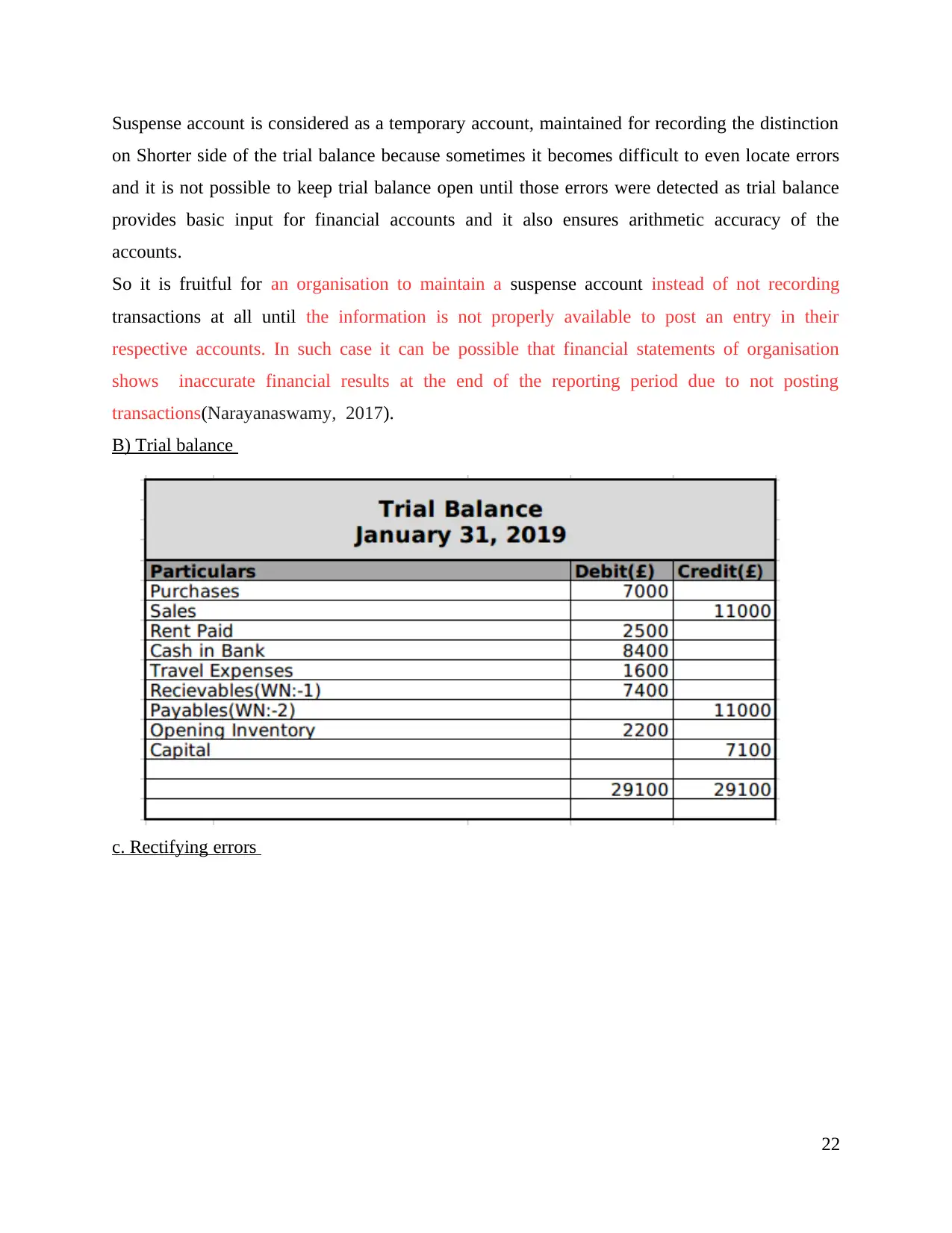
Suspense account is considered as a temporary account, maintained for recording the distinction
on Shorter side of the trial balance because sometimes it becomes difficult to even locate errors
and it is not possible to keep trial balance open until those errors were detected as trial balance
provides basic input for financial accounts and it also ensures arithmetic accuracy of the
accounts.
So it is fruitful for an organisation to maintain a suspense account instead of not recording
transactions at all until the information is not properly available to post an entry in their
respective accounts. In such case it can be possible that financial statements of organisation
shows inaccurate financial results at the end of the reporting period due to not posting
transactions(Narayanaswamy, 2017).
B) Trial balance
c. Rectifying errors
22
on Shorter side of the trial balance because sometimes it becomes difficult to even locate errors
and it is not possible to keep trial balance open until those errors were detected as trial balance
provides basic input for financial accounts and it also ensures arithmetic accuracy of the
accounts.
So it is fruitful for an organisation to maintain a suspense account instead of not recording
transactions at all until the information is not properly available to post an entry in their
respective accounts. In such case it can be possible that financial statements of organisation
shows inaccurate financial results at the end of the reporting period due to not posting
transactions(Narayanaswamy, 2017).
B) Trial balance
c. Rectifying errors
22
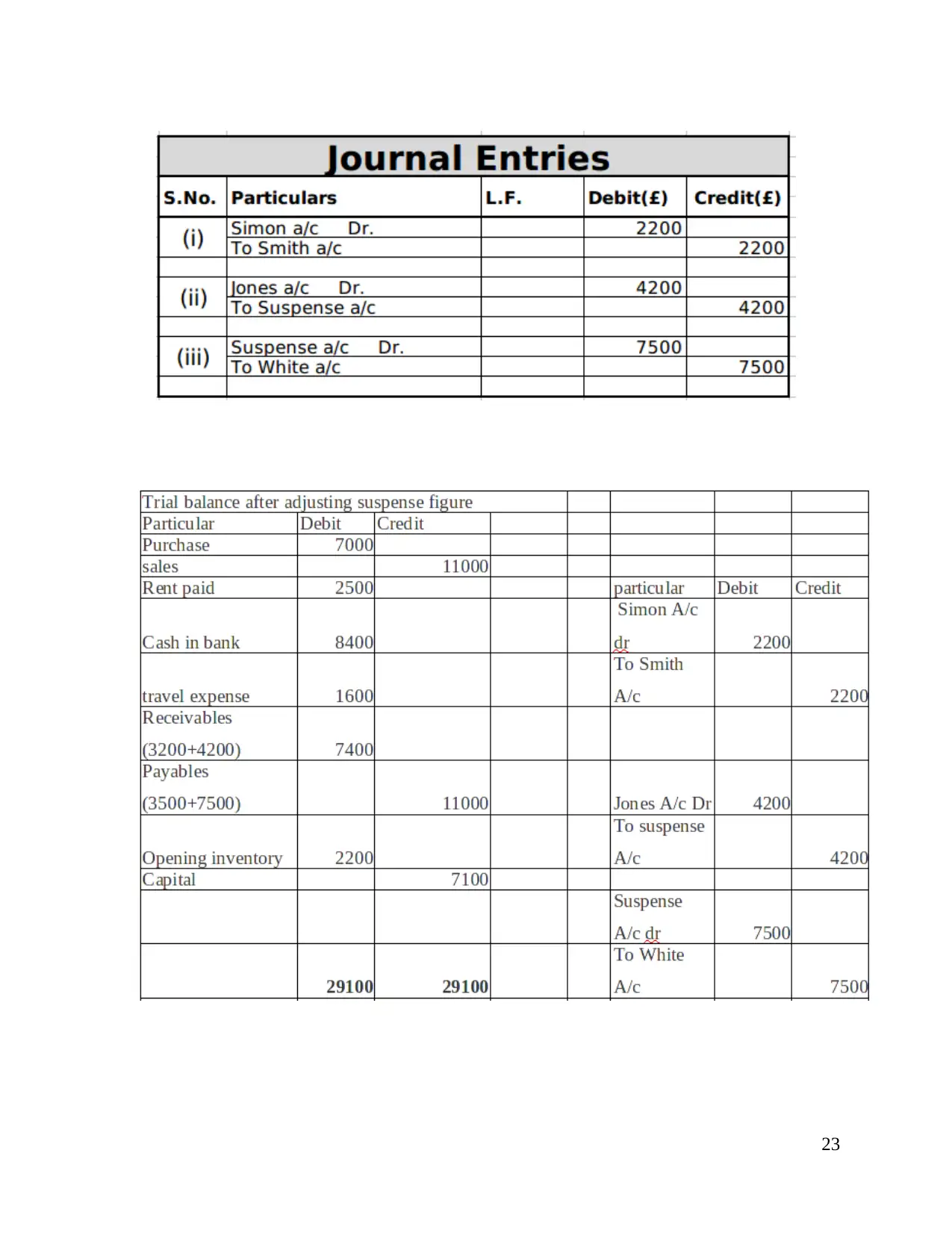
23
Secure Best Marks with AI Grader
Need help grading? Try our AI Grader for instant feedback on your assignments.
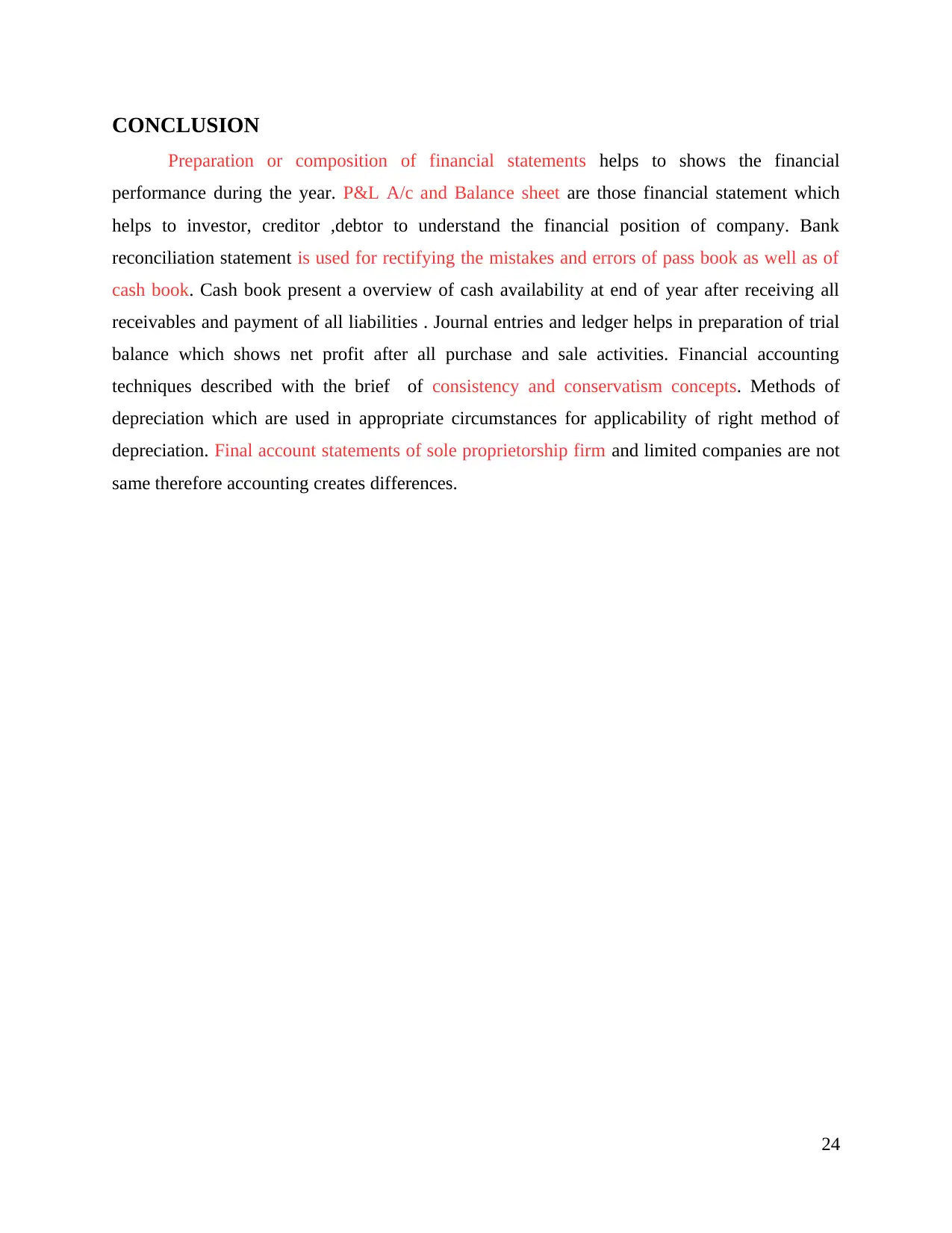
CONCLUSION
Preparation or composition of financial statements helps to shows the financial
performance during the year. P&L A/c and Balance sheet are those financial statement which
helps to investor, creditor ,debtor to understand the financial position of company. Bank
reconciliation statement is used for rectifying the mistakes and errors of pass book as well as of
cash book. Cash book present a overview of cash availability at end of year after receiving all
receivables and payment of all liabilities . Journal entries and ledger helps in preparation of trial
balance which shows net profit after all purchase and sale activities. Financial accounting
techniques described with the brief of consistency and conservatism concepts. Methods of
depreciation which are used in appropriate circumstances for applicability of right method of
depreciation. Final account statements of sole proprietorship firm and limited companies are not
same therefore accounting creates differences.
24
Preparation or composition of financial statements helps to shows the financial
performance during the year. P&L A/c and Balance sheet are those financial statement which
helps to investor, creditor ,debtor to understand the financial position of company. Bank
reconciliation statement is used for rectifying the mistakes and errors of pass book as well as of
cash book. Cash book present a overview of cash availability at end of year after receiving all
receivables and payment of all liabilities . Journal entries and ledger helps in preparation of trial
balance which shows net profit after all purchase and sale activities. Financial accounting
techniques described with the brief of consistency and conservatism concepts. Methods of
depreciation which are used in appropriate circumstances for applicability of right method of
depreciation. Final account statements of sole proprietorship firm and limited companies are not
same therefore accounting creates differences.
24
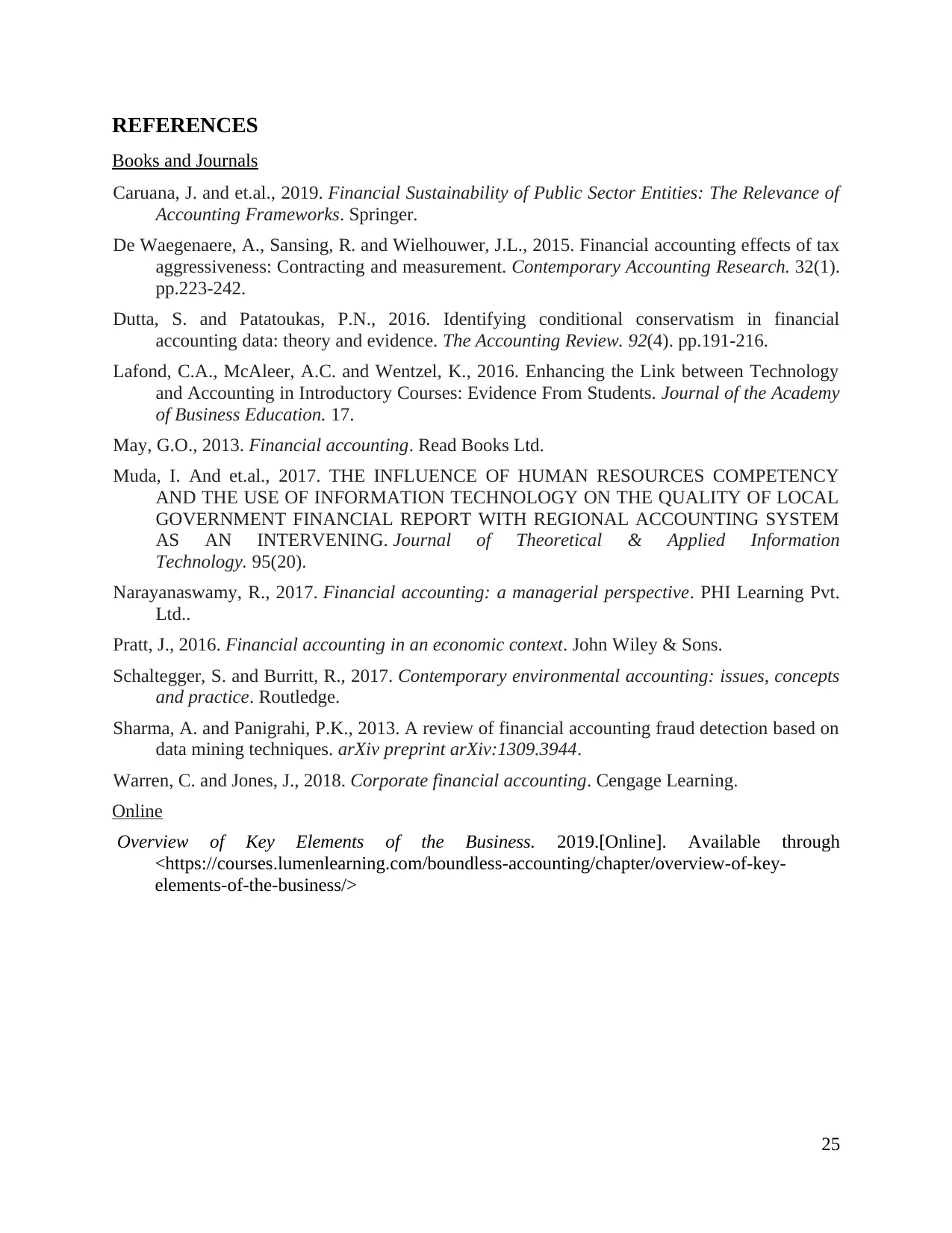
REFERENCES
Books and Journals
Caruana, J. and et.al., 2019. Financial Sustainability of Public Sector Entities: The Relevance of
Accounting Frameworks. Springer.
De Waegenaere, A., Sansing, R. and Wielhouwer, J.L., 2015. Financial accounting effects of tax
aggressiveness: Contracting and measurement. Contemporary Accounting Research. 32(1).
pp.223-242.
Dutta, S. and Patatoukas, P.N., 2016. Identifying conditional conservatism in financial
accounting data: theory and evidence. The Accounting Review. 92(4). pp.191-216.
Lafond, C.A., McAleer, A.C. and Wentzel, K., 2016. Enhancing the Link between Technology
and Accounting in Introductory Courses: Evidence From Students. Journal of the Academy
of Business Education. 17.
May, G.O., 2013. Financial accounting. Read Books Ltd.
Muda, I. And et.al., 2017. THE INFLUENCE OF HUMAN RESOURCES COMPETENCY
AND THE USE OF INFORMATION TECHNOLOGY ON THE QUALITY OF LOCAL
GOVERNMENT FINANCIAL REPORT WITH REGIONAL ACCOUNTING SYSTEM
AS AN INTERVENING. Journal of Theoretical & Applied Information
Technology. 95(20).
Narayanaswamy, R., 2017. Financial accounting: a managerial perspective. PHI Learning Pvt.
Ltd..
Pratt, J., 2016. Financial accounting in an economic context. John Wiley & Sons.
Schaltegger, S. and Burritt, R., 2017. Contemporary environmental accounting: issues, concepts
and practice. Routledge.
Sharma, A. and Panigrahi, P.K., 2013. A review of financial accounting fraud detection based on
data mining techniques. arXiv preprint arXiv:1309.3944.
Warren, C. and Jones, J., 2018. Corporate financial accounting. Cengage Learning.
Online
Overview of Key Elements of the Business. 2019.[Online]. Available through
<https://courses.lumenlearning.com/boundless-accounting/chapter/overview-of-key-
elements-of-the-business/>
25
Books and Journals
Caruana, J. and et.al., 2019. Financial Sustainability of Public Sector Entities: The Relevance of
Accounting Frameworks. Springer.
De Waegenaere, A., Sansing, R. and Wielhouwer, J.L., 2015. Financial accounting effects of tax
aggressiveness: Contracting and measurement. Contemporary Accounting Research. 32(1).
pp.223-242.
Dutta, S. and Patatoukas, P.N., 2016. Identifying conditional conservatism in financial
accounting data: theory and evidence. The Accounting Review. 92(4). pp.191-216.
Lafond, C.A., McAleer, A.C. and Wentzel, K., 2016. Enhancing the Link between Technology
and Accounting in Introductory Courses: Evidence From Students. Journal of the Academy
of Business Education. 17.
May, G.O., 2013. Financial accounting. Read Books Ltd.
Muda, I. And et.al., 2017. THE INFLUENCE OF HUMAN RESOURCES COMPETENCY
AND THE USE OF INFORMATION TECHNOLOGY ON THE QUALITY OF LOCAL
GOVERNMENT FINANCIAL REPORT WITH REGIONAL ACCOUNTING SYSTEM
AS AN INTERVENING. Journal of Theoretical & Applied Information
Technology. 95(20).
Narayanaswamy, R., 2017. Financial accounting: a managerial perspective. PHI Learning Pvt.
Ltd..
Pratt, J., 2016. Financial accounting in an economic context. John Wiley & Sons.
Schaltegger, S. and Burritt, R., 2017. Contemporary environmental accounting: issues, concepts
and practice. Routledge.
Sharma, A. and Panigrahi, P.K., 2013. A review of financial accounting fraud detection based on
data mining techniques. arXiv preprint arXiv:1309.3944.
Warren, C. and Jones, J., 2018. Corporate financial accounting. Cengage Learning.
Online
Overview of Key Elements of the Business. 2019.[Online]. Available through
<https://courses.lumenlearning.com/boundless-accounting/chapter/overview-of-key-
elements-of-the-business/>
25
1 out of 30
Related Documents
Your All-in-One AI-Powered Toolkit for Academic Success.
+13062052269
info@desklib.com
Available 24*7 on WhatsApp / Email
![[object Object]](/_next/static/media/star-bottom.7253800d.svg)
Unlock your academic potential
© 2024 | Zucol Services PVT LTD | All rights reserved.





